14 – 31 October 2024
By Joshua Olszewski
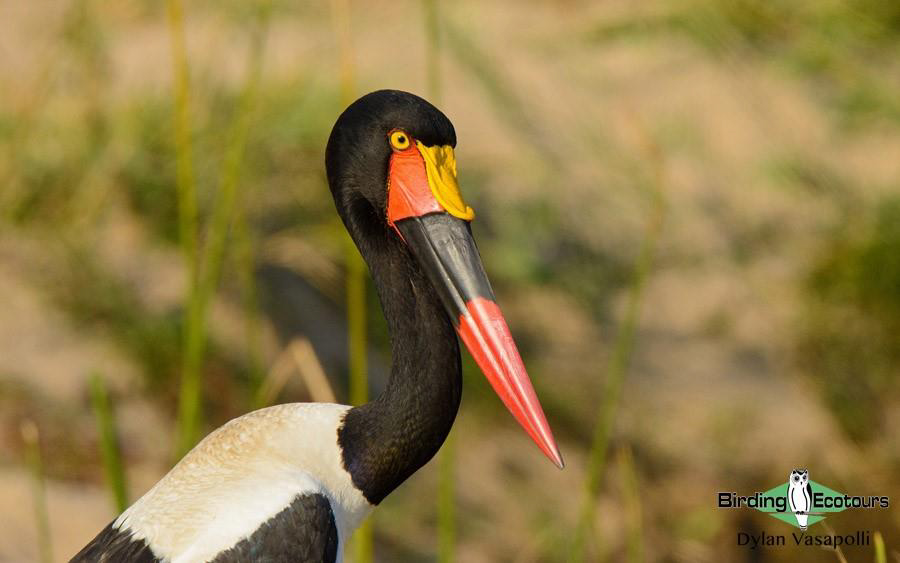
The magnificent Saddle-billed Stork was one of the highlights from our time in Kruger!
Overview
From high mountains to humid coastal forests, desert to savanna woodland, South Africa has a variety of habitats that is hard to match. This, in turn, has led to an even more impressive variety and abundance of plant and animal species, many of which are found nowhere else in the world. The bird diversity is particularly noteworthy, with over 850 species on offer across the different ecozones. On this 18-day tour, we spent much of our time traversing the warm subtropical forests and savannas in the east of South Africa, making brief forays into the cooler, more temperate grasslands and mountainous regions like Wakkerstroom, Dullstroom and Sani Pass in the Drakensberg Mountains.
Across all these biomes, we managed to amass a list of over 400 bird species, with notable highlights including Drakensberg Rockjumper, Bearded Vulture, Pink-throated Twinspot, Narina Trogon, Livingstone’s Turaco, Rudd’s Lark, Martial Eagle, Wattled Crane, African Skimmer, Orange Ground Thrush, Crimson-breasted Shrike and Southern White-faced Owl amongst many others. Our days in the famous Kruger National Park provided us with impeccable mammal sightings which included multiple Leopards and a pack of African Wild Dogs that we saw in excess of three times!
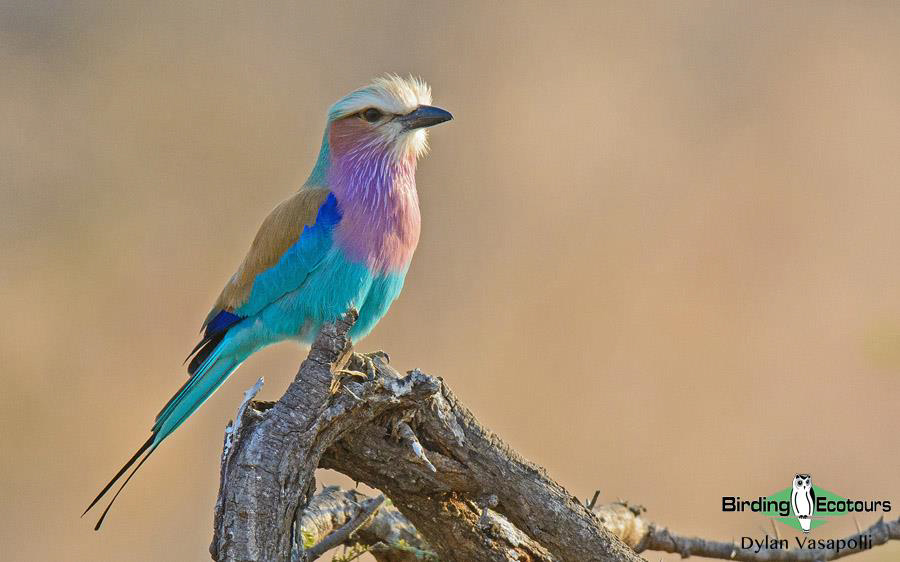
It’s hard to beat the vivid beauty of the Lilac-breasted Roller, especially against the backdrop of brown and green savanna.
A detailed daily account can be read below, and the full bird and mammal lists are located at the end of the report.
Detailed Report
Day 1, 14th October 2024. Arrival in Durban, local birding and transfer to Pennington
Most of the tour group was already staying in Durban from the previous day, and had great views of Cape Starling, African Woolly-necked Stork and Hadada Ibis upon leaving their accommodation at Mount Edgecombe this morning. However, this was essentially a travel day, as the tour participants made their way to Botha House in the picturesque Umdoni Park Golf Estate, south of Durban, along the coast. Not much birding was done this afternoon once we had arrived at Botha House, due to the wind and rain, so we decided to call it in and enjoy dinner and some great conversations about all the great birds we were to see over the next two weeks.
Day 2, 15th October 2024. Birding Umdoni Park, and transfer to Underberg, via Ixopo
Before breakfast we went out for an early morning walk through the lush forests around Umdoni Park. This got us adjusted to some of the local forest species, such as Tambourine Dove, Yellow-bellied Greenbul, Purple-crested Turaco, Olive, Grey and Collared Sunbirds, Black-headed Oriole, Red-capped Robin-Chat, Ashy and Southern Black Flycatcher, Yellow-rumped Tinkerbird, Square-tailed Drongo and Bar-throated Apalis. Other interesting species seen on the verges of the forest included Southern Black Tit, Green Wood-Hoopoe, Thick-billed Weaver, Tawny-flanked Prinia and a brief Crowned Eagle seen by some of the clients. A large flock of swallows flying overhead consisted mostly of Lesser Striped Swallows, along with smaller numbers of Black Saw-wings and Brown-throated, Large Rock and Western House Martins.After breakfast, we ambled around the gardens surrounding the house, which delivered the localized Southern Tchagra, as well as Yellow-fronted Canary, African Pied Wagtail, Brown-hooded Kingfisher, Village Weaver, Cape Robin-Chat, a responsive Cardinal Woodpecker and both White-eared and Black-collared Barbets.
We then left Pennington and headed inland towards the Drakensberg, making a midday stop near the village of Ixopo. Here we tried for Blue Swallow, which did not show, but we did manage to find African Firefinch, Buff-streaked Chat, Southern Boubou, African Stonechat and a confiding pair of Brimstone Canaries. We pushed on towards the Drakensberg, being treated to fly-bys from Jackal Buzzard, White-necked Raven, and Yellow-billed Kite. Upon taking the gravel road down to our scenic lakeside accommodation, we connected with Bokmakierie, Red-collared Widowbird and interesting waterbirds along the lake shore. These included Little Grebe, Yellow-billed Duck, Levaillant’s Cisticola and, best of all, a pair of Wattled Cranes! These elegant birds are sparse and uncommon in South Africa, so bumping into this pair was really special. We then turned in for the evening, enjoying Common Moorhen, Grey Heron, Pied Kingfisher, Blacksmith Lapwing, and Yellow-billed Duck on the ponds outside our chalets, before settling down for dinner..
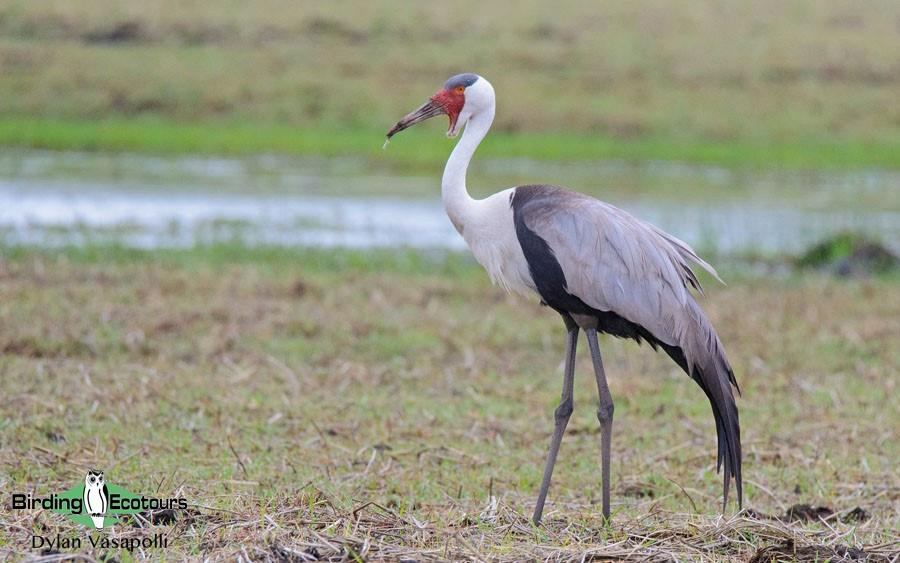
It was a great surprise to find a pair of Wattled Cranes near our Drakensberg accommodation.
Day 3, 16th October 2024. Endemic birding on Sani Pass, and into Lesotho
Today was a fantastic day of birding along the spectacular Sani Pass: a 15-kilometer-long mountain pass that ascends the dramatic Maluti-Drakensberg Mountains and crosses the border into Lesotho at the top. The farmsteads near the bottom of the pass were our first port of call. These delivered interesting species like African Paradise Flycatcher, Olive Thrush, Golden-tailed Woodpecker and a showy young Bush Duiker. Further along, the grassy, boulder-strewn slopes and valleys along the pass started to give up some proper Drakensberg and Afromontane specials. These included the endemic Gurney’s Sugarbird, as well as Rock Kestrel, Wailing Cisticola, Malachite and Greater Double-collared Sunbird, Buff-streaked Chat, Nicholson’s Pipit, Cape Rock Thrush, Yellow Bishop, Cape Grassbird and the bizarre Ground Woodpecker. The noisy Red-throated Wryneck was also found in this area, and the loud calls of Barratt’s Warblers rang out from every gulley filled with thickets of woody Ouhout shrubs (though we would have to wait until later in the day before laying eyes on one of these secretive warblers).
The Ouhout thickets around the South African border post produced several interesting species, like Drakensberg Prinia, Streaky-headed Seedeater, the attractive African Yellow Warbler and an unexpected Willow Warbler (an early arrival from Europe). A Karoo Prinia was also found in one of these Ouhout thickets further down the pass; rather unusual considering this is normally where one sees the Drakensberg Prinias,while the Karoo Prinias tend to stay in the scrubbier karroid vegetation on top of the pass.
This drier, scrubby habitat became more prevalent as we ascended the last few kilometers of the pass. Here, the vistas over the valley behind us were simply breathtaking as we trudged up the rugged switchbacks. One of these switchbacks was especially productive, as it delivered our first looks at Drakensberg Siskin and very close views of a male Drakensberg Rockjumper. Bathing in the adjacent stream and foraging meters beneath our feet, we were treated to impeccable views of this gorgeous, charismatic and highly sought-after endemic.
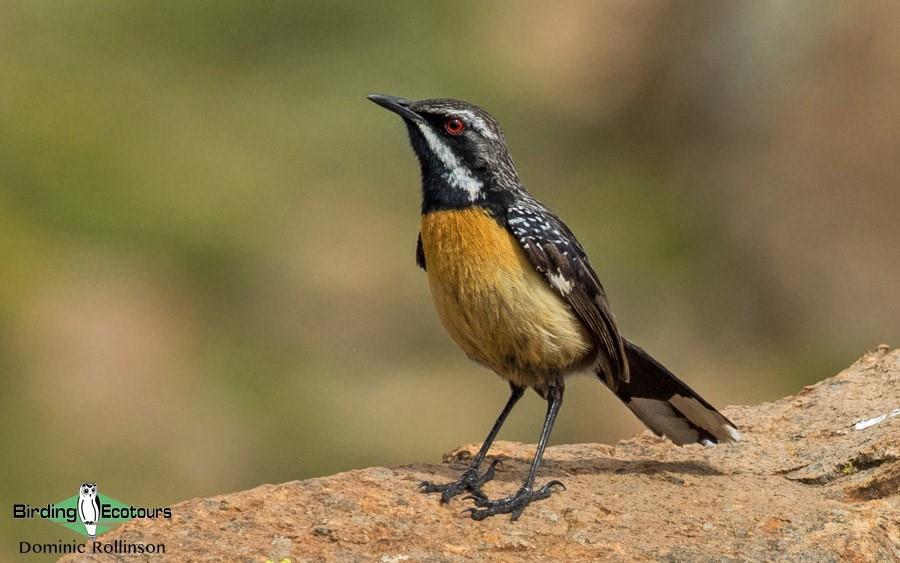
Rockjumpers are an endemic southern African family, and the Drakensberg Rockjumper is always a major target on Sani Pass.
After going through the border control at the top of the pass, we journeyed over the vast expanse of rolling plains and mountains covered in low karroid scrub. With this drastic change in habitat from the bottom of the pass, came a whole new suite of birds. Some of the first that we connected with included Large-billed Lark, Sickle-winged Chat and the colorful Sentinel Rock Thrush. We stopped for a roadside lunch break (which was delicious, courtesy of our local guide, Stuart) a few kilometers down the road, which proved to be quite fruitful. A majestic young Bearded Vulture came flying low overhead multiple times during this time, seeming to investigate the surrounding slopes for bones. Other raptors seen included a pair of Lanner Falcons, a Verreaux’s Eagle being chased by a pair of Jackal Buzzards and a couple of Cape Vultures. The scrub around our lunch spot was not to be outdone, and produced Layard’s Warbler, Fairy Flycatcher and Cape Bunting.
After lunch, we started on the journey back, carefully scanning and working the roadside plains for one of our main targets. Eventually, after some struggling, we managed to connect with two pairs of Mountain Pipit, one even collecting food! The old stone ruins just before the border control gave us much better views of a pair of Drakensberg Siskins, as well as the cute Sloggett’s Vlei Rat and our first Red-capped Larks of the trip. Shiny Cape Crows and Southern Bald Ibis walked around the grassy patches near the border control offices, which were home to several attractive Cape Sparrows. After once again passing through border control back into South Africa, we slowly descended the switchbacks, relishing the golden evening light being thrown across the green and yellow valley below us. A couple of Rock Hyrax were sunning themselves on the roadside boulders as we went. Returning to our lodge, we once again scanned the lake as we arrived, which delivered many of the same species we had already seen, with the addition of a single Common Greenshank, and vibrant Cape Longclaws in the surrounding grass. Close views of Pied Starling were also welcome, and returning to the lake shore after dark delivered a roosting family of South African Shelducks, complete with five fledglings. Mountain Reedbuck and a lone Scrub Hare were also some of the nocturnal additions to the trip list.
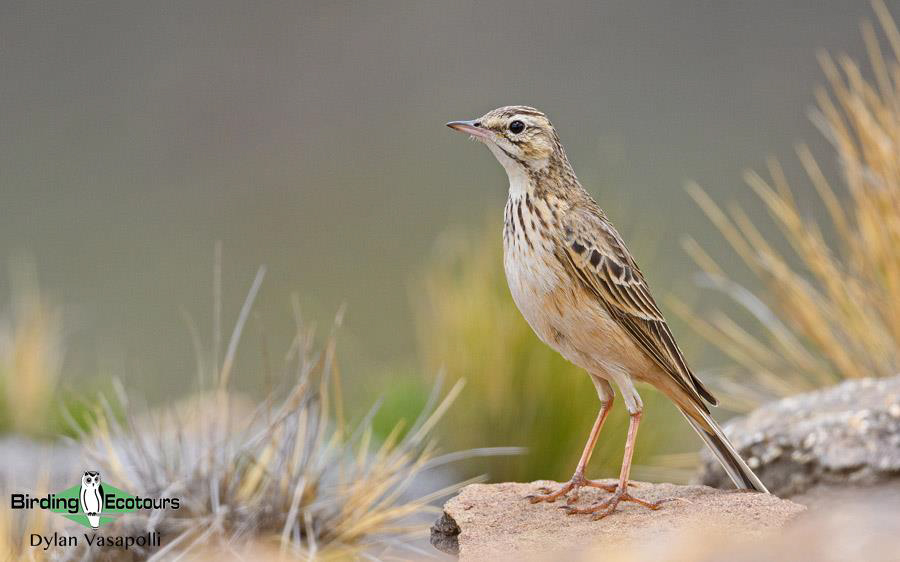
Although Mountain Pipit breeds in the high Drakensberg mountains, their non-breeding range still remains a mystery!
Day 4, 17th October 2024. Sani Valley and Benvie Gardens, transfer to Eshowe
We decided to take an early morning walk around the small lakes directly in front of our chalets at Sani Valley Lodge. With good lighting, we enjoyed views of African Swamphen, Yellow-billed, Great and Little Egrets, Grey Heron, Pied Kingfisher, White-faced Whistling Duck, Reed and White-breasted Cormorant and at least fifteen Black-crowned Night Herons! After leaving Sani Valley, we were once again treated to many Cape Crows, White-necked Ravens and Jackal Buzzards as we journeyed east away from the mountains. It didn’t take long for us to find the first of many Long-crested Eagles we would see that day. Just outside Underberg we stumbled upon a fallow field filled with at least 40 Grey Crowned Cranes, including a very enthusiastic bird doing the famous “crane dance”, though none of his congeners seemed eager to join him! We also made a brief stop at Marutswa Forest in the hopes of getting Cape Parrot, but we had to settle for African Pipit, a showy Amethyst Sunbird and fly-bys from both Long-crested Eagle and African Harrier-Hawk
Later in the day, we made it to the tranquil Benvie Gardens in the Karkloof Conservancy. The pink and red Azalia bushes beneath giant Himalayan pines alongside Afromontane forest create a beautiful, if not unorthodox, environment to see the secretive Orange Ground Thrush. This spot is one of the best places to see this thrush, and we soon found a relaxed pair with a nest right next to the path, seemingly unbothered by our presence. A large mixed flock of Bronze and Black-and-white (Red-backed) Mannikins was also a nice find, as was a pugnacious Green-backed Camaroptera that almost attacked my speaker! The many blossoms in the gardens produced many Southern Double-collared Sunbirds and singletons of Olive and Collared Sunbird.
Leaving Benvie behind, we continued east towards Eshowe, without much more birding, but notably finding another field full of cranes, although this time they were Blue Cranes, South Africa’s national bird. With all three crane species in the bag, we completed the long drive to Eshowe and enjoyed a hearty dinner at our lovely accommodation.
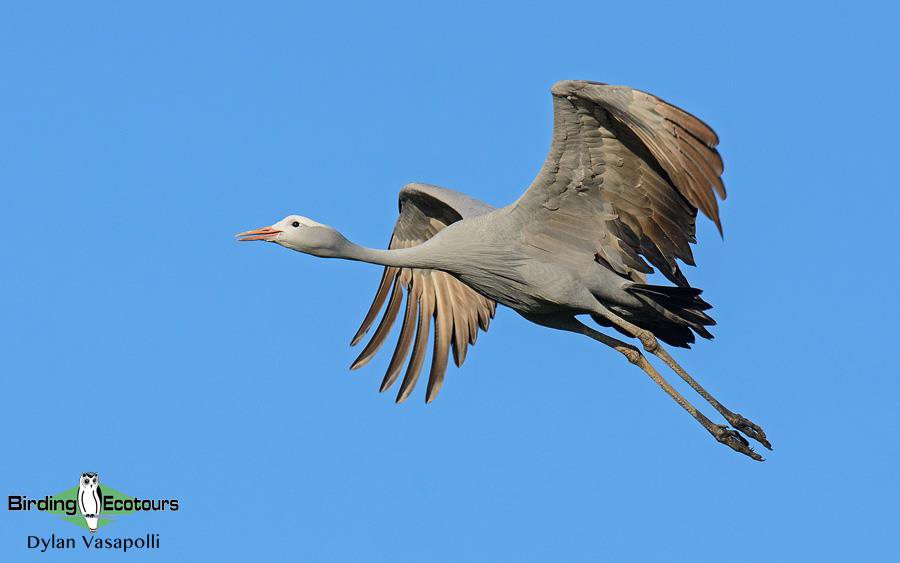
The regal Blue Crane was the last of South Africa’s three crane species to be seen on this tour.
Day 5, 18th October 2024. Birding Ongoye and Dlinza Forests
We made our way down to Mtunzini at sunrise to fetch our local guide, stopping en route in the lush coastal forest near Mtunzini Forest Lodge. As we drove the dirt track towards the lodge, a Palm-nut Vulture flushed from the roadside and sat low down in a tree next to the road. We took the time to enjoy these unusually close-up views of this strange and beautiful raptor. After picking up our guide, Junior, we made another stop in Mtunzini town to enjoy large numbers of Trumpeter Hornbills foraging in a fruiting fig tree. The ringing calls of a Crested Barbet also got our attention, and the bird showed very well alongside the more abundant White-eared Barbets and Yellow-rumped Tinkerbirds. African Pied Wagtails tended the suburban lawns, and other good birds seen in the parks and gardens around town included Violet-backed and Black-bellied Starlings and Purple-crested Turaco.
We then headed north again, this time in the direction of Ongoye Forest. This large patch of Afromontane forest is well known in birding circles for hosting southern Africa’s only population of Green Barbet. The subspecies here, woodwardii, is also endemic to this forest, and differs from those further north in having bright yellow ear coverts. We birded a section of the forest that crossed the main road, and swiftly connected with a pair of these rare barbets singing their hearts out. This stretch of road was very productive, and in an hour we had scored views of Dark-backed Weaver, Cape Batis, Terrestrial Brownbul, Yellow-streaked Greenbul, Brown Scrub Robin and multiple Narina Trogons. The rocky grassland outside the forest gave us a single Plain-backed Pipit, while a Common Buzzard soared overhead with one of the ubiquitous Yellow-billed Kites.
Backtracking towards Mtunzini, the roadside birding kept us entertained with Fan-tailed Widowbirds flying over the cane fields, and African Woolly-necked Storks accompanying the common Hadada Ibis in the fallow fields. Lesser Striped Swallows were frequently seen along the telephone lines, while Rufous-naped Lark was less common. We made an impromptu visit to the grasslands around a small dam near Emoyeni, where we managed stunning views of a flushed Swamp Nightjar. Another Palm-nut Vulture was also seen roosting on a distant Raffia palm, and we also added Neddicky to the trip list. A Jackal Buzzard was also an unexpected sight in this area.
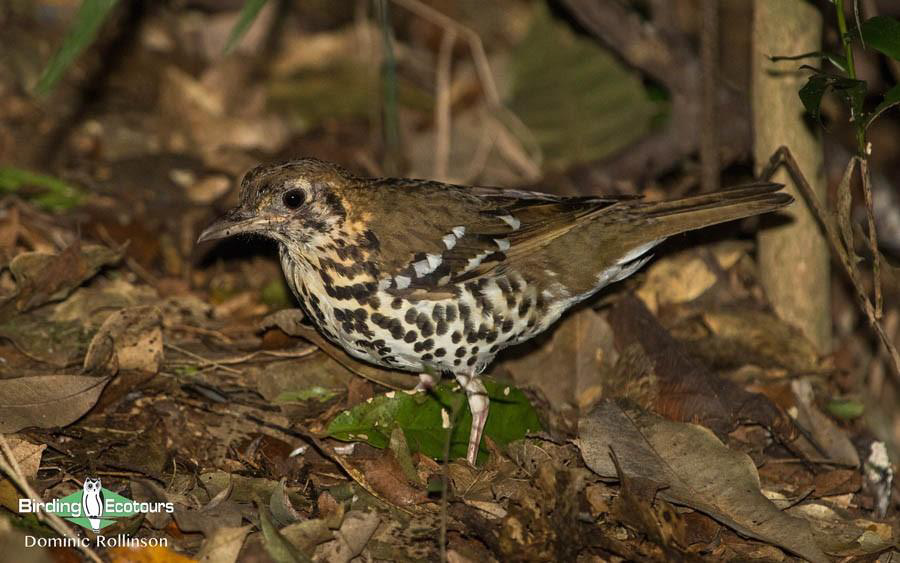
Dlinza forest is the only spot on this tour for the scarce Spotted Ground Thrush.
Returning to Mtunzini, we decided to bird a few spots in Umlalazi Nature Reserve south of town. Additions made to the trip list around the reserve included Purple-banded Sunbird, Yellow-breasted Apalis, African Paradise Flycatcher, Eastern Golden Weaver and, best of all, a pair of Green Malkohas. These secretive cuckoos really made us work for good views of them, but eventually we were rewarded for our efforts. What was supposed to be another brief stop at one of the parks in town turned out to be very fruitful, delivering a calling Scaly-throated Honeyguide, Red-chested Cuckoo and our best views of Narina Trogon. Our final stop in Mtunzini was the forests near the Raffia Palm Monument alongside Umlalazi. The main additions here were two flighty Blue-mantled Crested Flycatchers and a male Black-throated Wattle-eye.
Returning to Eshowe, we had enough time to pay a quick visit to the nearby Dlinza Forest. Despite the light rain, we once again scored a few new species, most notable of which were numbers of Lemon Dove and a single Tambourine Dove pottering around the hide next to reception. Seeing that many individuals of such a shy species was very special. After quick views of both Red-capped and Chorister Robin-Chats, we left Dlinza and made it back to our lodge, with enough time to relax before dinner, for once!
Day 6, 19th October 2024. Dlinza Forest, transfer to St Lucia
With gloomy weather looming over Eshowe this morning, we made an early start and birded the well-known Dlinza Forest on the outskirts of town. Upon entering the forest, we were greeted by a pair of incredibly confiding Narina Trogons. Given how hard we had to work the day before to get a good visual of this bird, this was a welcome sighting.The aerial boardwalk was rather quiet, with nothing but a few distant Black-bellied Starlings showing. Things didn’t get much easier down on the trails beneath the high canopy and grey skies. However, it also didn’t take long for us to find one of our main targets: a Spotted Ground Thrush, ironically, singing high in a tree. This is a key site in South Africa for this localized species.
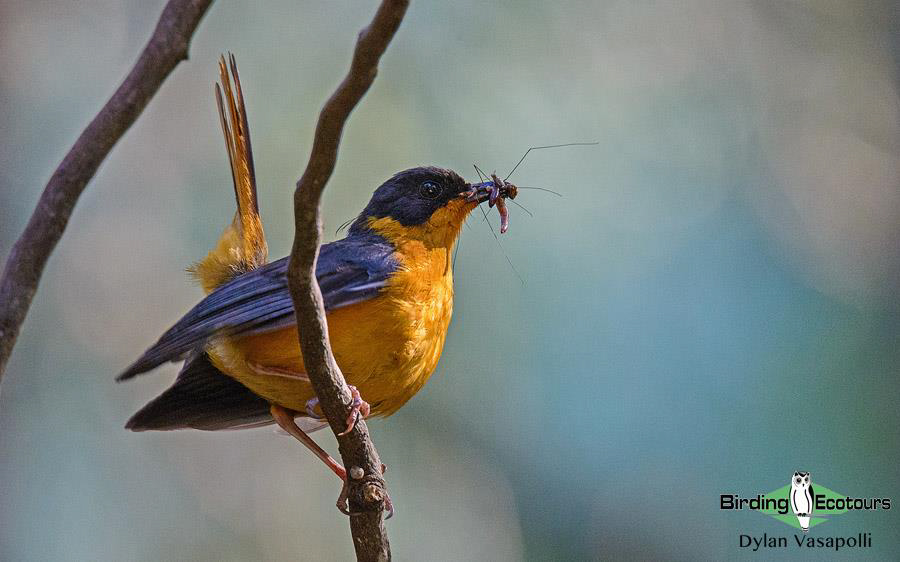
Chorister Robin-Chats were shy but common on the forest floor at Dlinza.
Continuing through the forest, we slowly started accumulating more species such as Olive Thrush, Chorister Robin-Chat, Terrestrial Brownbul and Cape Batis. Hearing another Scaly-throated Honeyguide making its strange call from its calling post was also noteworthy. Eventually, we struck gold when we stumbled into a bustling mixed species foraging party in an opening in the forest canopy. Here we quickly amassed a large number of species. Amidst the myriad of Collared Sunbirds, Cape White-eyes, Black-backed Puffbacks, Yellow-breasted Apalis and Chorister Robin-Chats, we managed to pick out an Olive Woodpecker, a couple of Olive Bushshrikes, a surprisingly showy Green Malkoha and, least expected of all, a Bush Blackcap. The latter is quite rare at this site. We only ended up hearing Grey Cuckooshrike and African Emerald Cuckoo, along with more species we’d already seen like Southern Boubou, Narina Trogon, Bar-throated Apalis, Sombre and Yellow-bellied Greenbul and Tambourine Dove. We also enjoyed a rather unbothered Blue Duiker feeding alongside the trail, a great opportunity to observe this shy antelope.
After paying another visit to the Lemon Doves at the hide near reception, we then left Dlinza and headed back to our accommodation for a lovely sit-down breakfast. We had great looks at a male Klaas’s Cuckoo and a Southern Grey-headed Sparrow,before checking out and making our way back towards Mtunzini. A young Lanner Falcon perched on a roadside telephone pole was a pleasant, albeit unexpected distraction. We stopped at a sugarcane field lying fallow just north of town, which played host to a breeding colony of about 40 Collared Pratincoles. We took the time to enjoy these elegant “waders” resting in the field and noisily flying around us, picking up a Kittlitz’s Plover with a chick in the process. The taller cane field next door delivered great views of Rufous-winged Cisticola, and a displaying Rufous-naped Lark. After our final addition at this spot in the form of a female Pin-tailed Whydah, we headed into town for lunch. A short drive down to the nearby Raphia Palm monument also got us great looks at a Burchell’s Coucal attempting to sun itself on a dead bush.
Lunchtime done, we arrived in St Lucia in the early evening, where we relaxed and were serenaded by Southern Crested Guineafowl before heading out to a fabulous dinner in town.
Day 7, 20th October 2024. Birding the Eastern Shores of the Isimangaliso Wetland Park
We had a slightly later start this morning to avoid the rain that had been predicted. Fortunately, it held out for most of the day and remained cloudy, yet comfortable. Our day started with good looks at Southern Crested Guineafowl, Red-capped Robin-Chat and Yellow-bellied Greenbul at our accommodation, before heading towards Bhangazi Gate. A brief stop at the bridge over the narrow section of the St Lucia estuary delivered a couple of male Southern Brown-throated Weavers chasing each other around the reeds. A few Common Swifts were seen flying high above the masses of Little Swifts that circled the bridge, and a male Diederik Cuckoo perched obligingly in a tree next to the carpark. We also had brief looks at Common Reed Warbler and Lesser Swamp Warbler, flyovers from Grey-headed Gull and Caspian Tern, and our first proper looks at African Pied Wagtail.
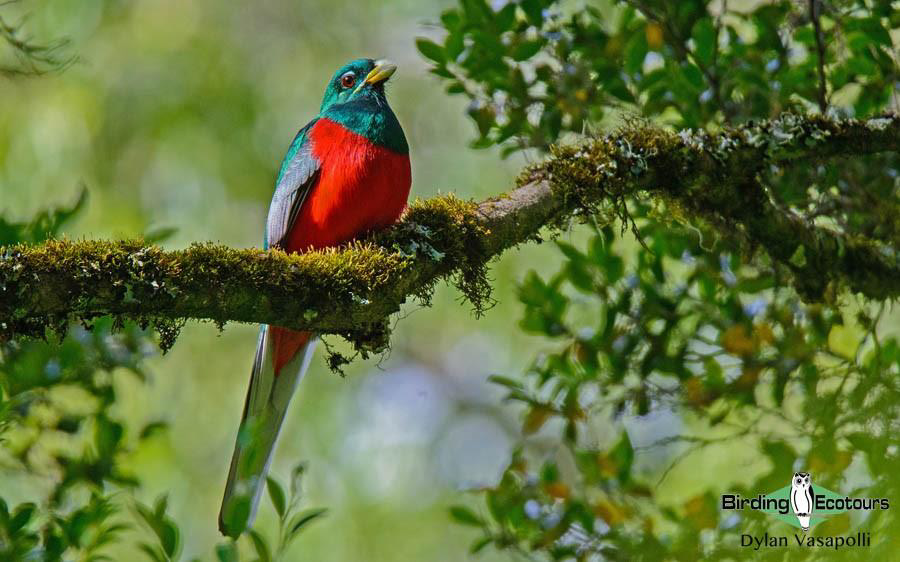
Almost every forest around Eshowe and Mtunzini delivered the gorgeous Narina Trogon.
Upon arriving at the gate, we were greeted by an African Goshawk circling high overhead, uttering its repetitive display call. We also got Crowned Hornbill and Black-collared Barbet around the gate, before heading off into the park. The first animals we saw as we entered the reserve were two Impala rams rutting half-heartedly. This was followed by a distant Black-chested Snake-Eagle sitting on a faraway tree. We then stopped at Amazibu hide, which overlooks a small wetland. Here we found Yellow-billed Egret, Lesser Masked Weaver, Croaking Cisticola, African Jacana, Reed Cormorant, Little Grebe, plenty of White-backed Ducks, a pair of White-faced Whistling Ducks and a male Rufous-bellied Heron (quite a rarity in South Africa). Another small pool a few meters down the road was just as productive, and provided point-blank views of Spur-winged Goose, White-backed Duck, another Rufous-bellied Heron (this one a female), Squacco Heron, Yellow-billed and Great Egret, Black-headed Heron, Eastern Golden Weaver, African Jacana and the jewel-like African Pygmy Kingfisher.
Continuing on through the park, we started picking up the first of many large game species, including Cape Buffalo, Plains Zebra, Blue Wildebeest and Waterbuck, while other small wetlands alongside the road added Malachite Kingfisher and Black Crake to the day list. Burchell’s Coucals were also quite a feature of the day, and we saw many perched out in the open after the erratic rain showers throughout the day. Rattling Cisticolas and Brown-hooded Kingfishers adorned the telephone lines, and Barn and Red-breasted Swallows were often seen flying low over the grasslands. The latter were particularly showy, often perching on low bushes alongside the road and singing their beautiful song. A distant flying raptor revealed itself to be an African Cuckoo-Hawk, while a larger one perched on a nearby telephone pole near the Mission Rocks turnoff, turned out to be the threatened Southern Banded Snake Eagle. We had stunning views of this rare raptor, and spent some time watching it sit sluggishly on its mid-morning vigil for snakes. Driving to and from our brunch stop at Mission Rocks, we had several sightings of tame Southern Crested Guineafowl next to the road. Watching their antics was quite entertaining, but they were quickly outdone by a beautiful African Cuckoo-Hawk perched near the roadside on the way out of Mission Rocks. This scarce raptor is not often encountered, let alone this well, so we once again took the time to admire this bird of prey as it preened itself, unbothered by the hordes of cameras firing away in its direction! We also had brief flyover views of two Livingstone’s Turacos, but the best views of this bird were still to come!
We pushed on towards Cape Vidal, picking up one or two Common Buzzards as we went and adding more mammals to the day list, including Greater Kudu, Southern Reedbuck, Southern Bushbuck, Bush Duiker and Warthog. Another addition to the growing list of close, perched raptor sightings was that of a young African Harrier-Hawk near Cape Vidal. As we descended into the coastal forest that surrounds Cape Vidal, we started noticing more Natal Red Duiker at the roadside, as well as one or two Blue Monkeys: a pleasant change from the ubiquitous Vervet Monkeys. Upon arrival at Cape Vidal, we took a stroll around the forests near the campgrounds, which delivered Trumpeter Hornbill, Blue-mantled Crested-Flycatcher, Terrestrial Brownbul, Sombre and Yellow-bellied Greenbul, Green-backed Camaroptera, Ashy Flycatcher, Southern Boubou and Golden-tailed Woodpecker. Above the curio shop, we managed to find a pair of Woodward’s Batis that showed very well. This range-restricted species can be quite shy and difficult to see well, so this was a noteworthy sighting. A large troop of Blue Monkeys also provided stellar views at this spot, including a partially leucistic baby that seemed golden brown in color! A sneaky African Goshawk would not be so obliging and only sat still for a second before fleeing from sight.
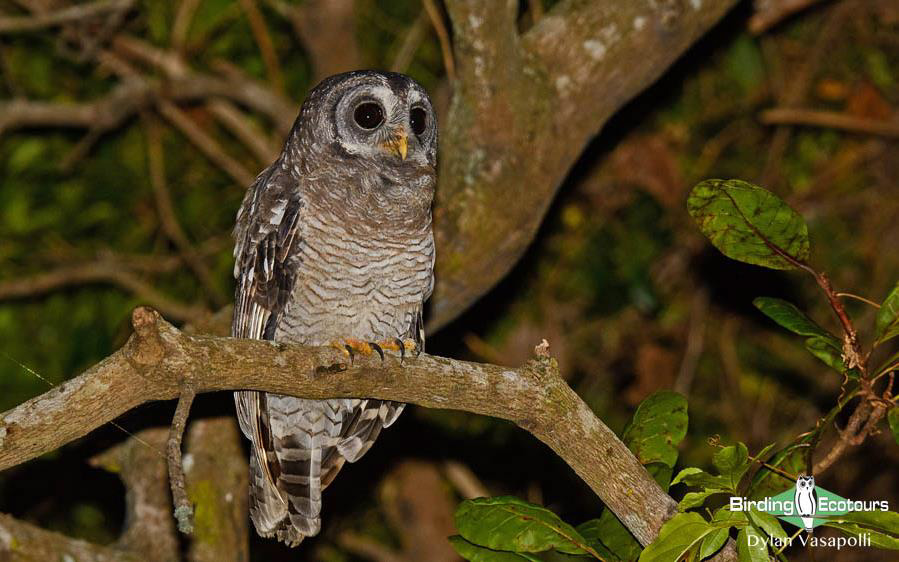
A pair of duetting African Wood Owls near our St Lucia accommodation was a surreal experience!
The drive back to St Lucia didn’t add a ton of new species, but we did get lovely views of two Little Bee-eaters sallying next to the road. A short foray down one of the dirt tracks in the reserve delivered a group of Collared Pratincoles roosting in the road (and not very willing to move, even for a motor vehicle!). They were also seen mobbing a distant African Marsh Harrier, while yet another Rufous-bellied Heron was seen flying in the opposite direction. A Pale-crowned Cisticola foraged at the road verge, while a Rufous-winged Cisticola provided more satisfactory views nearby. Other new day/trip species added along the main road included Black-collared Barbet, Yellow-throated Longclaw, Brimstone Canary, Scarlet-chested Sunbird, Spectacled Weaver, Western Cattle Egret and Red-billed Oxpecker (the latter two both seen sitting on buffalo!). The roadside pool near Amazibu hide added a Little Bittern and a stunning male African Pygmy Goose to the day list, before we left the park and headed into town for dinner. A final stop before returning home was at a nearby campsite where, in no time at all, we had brilliant views of a pair of African Wood Owls displaying above us. What a way to end a phenomenal day of birding in St Lucia!
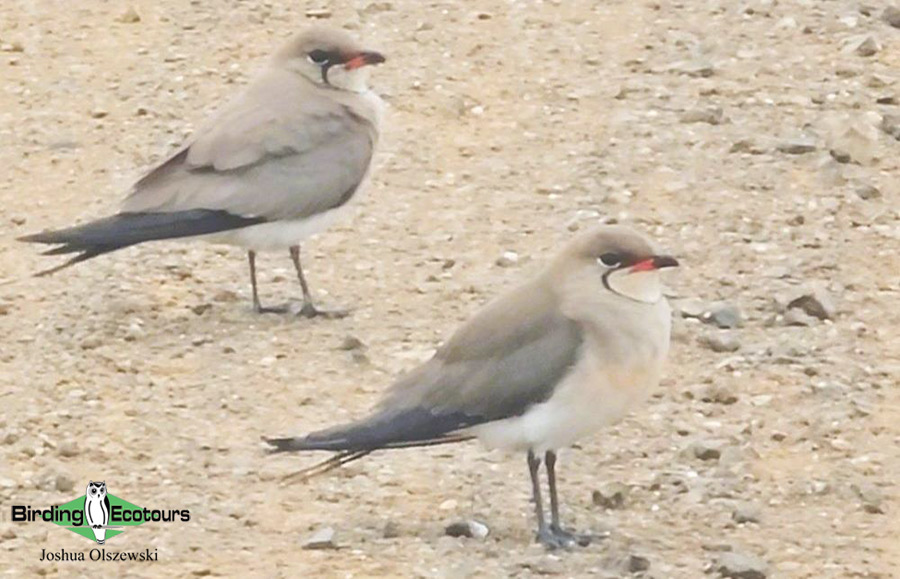
The elegant Collared Pratincole breeds alongside large pans and floodplains in Zululand during summer.
Day 8, 21st October 2024. Birding St Lucia, transfer to Hluhluwe
Our morning began by exploring the excellent iGwalagwala Trail running through the coastal forest around the town. The forest was alive with the calls of many of the afore-seen forest birds, while visual highlights included finally getting eyes on both Yellow-breasted and Rudd’s Apalis, a young Olive Bushshrike and a pair of Spectacled Weavers, while an African Goshawk displayed over canopy (lower down than yesterday’s one, too!). We got lucky when we heard a Buff-spotted Flufftail calling from a thicket next to the path. We decided to try coax it into view and were rewarded with brief views of the bird crossing the track in front of us. A Red Bush Squirrel foraging on a dead log was a great new mammal for the trip, and we managed to get eyes on yet another Green Malkoha,which turned out to be much showier than the previous ones.
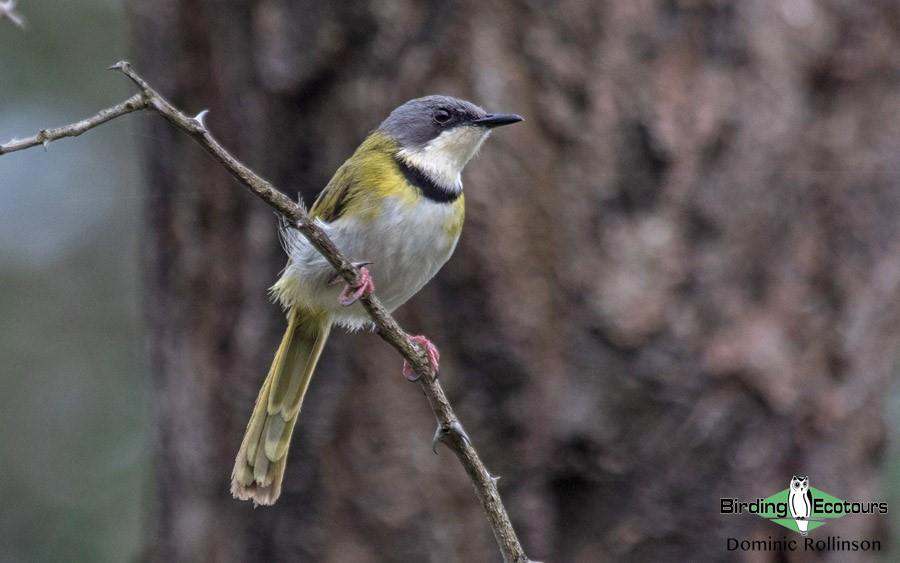
Although it is a localized, sand forest specialty, we had multiple great views of Rudd’s Apalis during our time in Zululand.
We then returned to the lodge for breakfast, after which we packed our bags and headed down to the St Lucia estuary mouth. Another group of Southern Crested Guineafowl and a female Thick-billed Weaver bid us farewell from our lodge as we made our way down to the estuary. The boardwalk down to the beach here delivered much better views of Black-throated Wattle-eye, while the adjacent reedbeds held Tawny-flanked Prinia, Lesser Swamp Warbler and Eastern Golden Weaver. The mouth itself held little of interest, but we managed to scratch out a small tern roost that consisted mostly of Caspian and Greater Crested Terns. Other birds seen included Grey Heron, Great Egret, Grey-headed Gull, Eurasian Whimbrel, Brimstone Canary and a distant pair of African Fish-Eagles. Heading back from the estuary into town, the lush forest along the road finally delivered the beautiful and desirable Livingstone’s Turaco, with two birds calling and showing superbly! Our first mousebird of the trip, a Speckled Mousebird, was also seen here, as was heard another Buff-spotted Flufftail. We then headed back into town for lunch, where the birding was surprisingly fruitful. We got great views of a male Scarlet-chested Sunbird, White-eared Barbet, a pair of Purple-crested Turacos and a mixed flock of Little, White-rumped and African Palm Swifts just around the restaurant!
After we had left St Lucia, we made our way north and lightly birded the dirt track that runs past Bonamanzi Game Reserve towards Hluhluwe. Bird life in the lush Acacia savanna here was bustling, and highlights included our first Wire-tailed Swallows, White-bellied Sunbird and Broad-billed Rollers of the trip, a dashing Orange-breasted Bushshrike, and herds of antelope that included Nyala, Impala and Southern Reedbuck. Lesser Striped Swallows landing on the road to collect mud for their nests was very special to see, and Lesser Masked Weaver, Village Weaver, Cape Starling, Southern Black Flycatcher, Black-winged and Yellow-billed Kite, and Red-billed Oxpecker were all seen along this road.
Upon reaching Kuleni Game Park and driving towards Umkhumbi Lodge, we had astonishing, eye-level views of a juvenile African Goshawk, while a walk around the lodge grounds after dinner revealed a calling Thick-tailed Greater Galago and a few interesting amphibians: Red Toad, Snoring Puddle Frog and Plain Grass Frog.
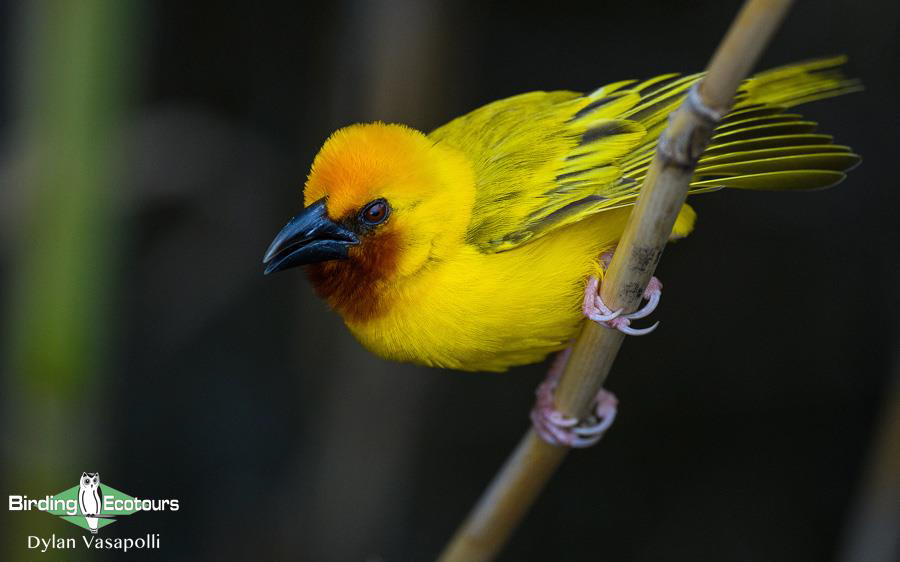
Weavers are plentiful in Zululand, and Southern Brown-throated Weaver was one of our targets while in the region.
Day 9, 22nd October 2024. Birding Muzi Pan and Mkhuze Game Reserve
With an early start we made our way out of Kuleni, being distracted by a stunning male Gorgeous Bushshrike, before heading in the direction of Mkuze Game Reserve. The dirt roads between Kuleni and the eastern gate of Mkuze were particularly bird-rich, and we started getting to grips with the plethora of savanna species that had become available to us. These included new trip species like Black-crowned Tchagra, European Bee-eater and Southern Masked Weaver. One stop in the hills just before the gate was especially productive and delivered Long-billed Crombec¸ Southern Red-fronted Tinkerbird, African Hoopoe, White-bellied Sunbird, Speckled Mousebird, Southern Black Tit, White-browed Scrub Robin and a stunning perched Jackal Buzzard.
After signing in at the gate, we took a break at the campsite just inside the park to have our breakfast and walk around. Exploring the camp grounds revealed a large number of species that showed quite well, such as Orange-breasted Bushshrike, Red-billed Oxpecker, Grey Tit-Flycatcher, Ashy Flycatcher, Southern Black Flycatcher, Mocking Cliff-Chat, Acacia Pied Barbet, Spectacled Weaver, Green Wood Hoopoe, Common Scimitarbill, Klaas’s Cuckoo, Red-chested Cuckoo, Kurrichane Thrush, Yellow-throated Bush Sparrow, Blue Waxbill, Yellow-breasted Apalis, Cardinal Woodpecker, Golden-tailed Woodpecker, Brown-crowned Tchagra, Scarlet-chested and Purple-banded Sunbirds and good numbers of Violet-backed Starlings amidst the ubiquitous Cape Starlings. Once the sun broke through the clouds, the humidity and heat shot up rapidly, and with that came lots of soaring raptors. Just over the campsite we had Black-chested and Brown Snake Eagle, a couple of White-backed Vultures, a beautiful low-flying Crowned Eagle and a Lanner Falcon that came stooping down at high speed, right into the campsite (in an attempt to catch the birds foraging around the car!). Both Barn and Lesser Striped Swallows were plentiful, with the latter landing at a small mud puddle near the camp entrance.
After we’d had our fill of the camp birding, we ventured into the park, finding a singing Sabota Lark, Striped Kingfisher, Tawny Eagle and even a local scarcity: a Dark Chanting Goshawk. We then arrived at Mantuma camp, where another brief walkabout got us good views of Little Bee-eater, Black Cuckooshrike, Brubru, Grey Waxbill and more mud-puddling Lesser Striped Swallows. We then headed to Kumasinga hide to have lunch and enjoy the wildlife surrounding the hide. The waterhole was full of Marsh Terrapins (some of which were eagerly waiting for lunch scraps below the hide!), while the shoreline played host to a number of bird species either bathing or coming to drink. This granted us to great views of Three-banded Plover, Blue Waxbill, Southern Grey-headed Sparrow, Yellow-fronted Canary, Emerald-spotted Wood Dove, Ring-necked Dove, Village and Lesser Masked Weaver and Sombre Greenbul. A Brown-hooded Kingfisher excavated a nest burrow in the bank across the water, while the neighboring flowering bushes delivered our first Marico Sunbird of the trip. A small group of Nyala came down to drink, with their resident fleet of Red-billed Oxpeckers, that also took the opportunity to have a drink. A Wahlberg’s Eagle swooping and soaring over the hide was a nice trip addition.
Driving out of the hide, we were greeted by a showy Crested Francolin and a less obliging Bearded Scrub Robin, both of which were making the most of a termite eruption that was happening along the track. Joining them were large numbers of African Bullfrog and Bushveld Rain Frog, the former needing to be escorted off the road due to their short legs and lack of self-preservation instincts! Avoiding the frogs, we were also treated to one or two Leopard Tortoises trodding along the main road. African Firefinch and another showy Sabota Lark were also seen along the main road. A distant roadside dam also revealed Waterbuck, Pied Kingfisher, Little Egret and Reed Cormorant. After leaving the park, we passed straight through a thunderstorm on our way back to Kuleni. However, there was a brief lull as we arrived at Muzi Pan, which got us Great White Pelican, White-faced Whistling Duck, Spur-winged Goose, Great Egret, African Jacana, Glossy Ibis, Little Grebe and a Goliath Heron. A few distant waders turned out to be Ruff and were the final additions of the day, before pushing through the rest of the thunderstorm (which was bucketing down quite hard in some places), and settling in for dinner by candlelight.
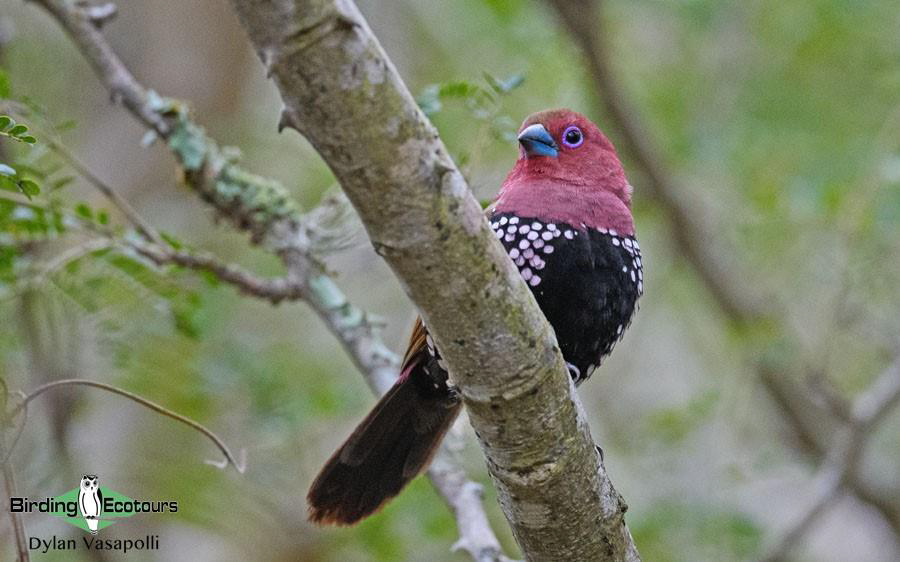
Like the Apalis, Pink-throated Twinspot is another delightful sand forest endemic that we saw beautifully at Kuleni..
Day 10, 23rd October 2024. Birding Hluhluwe and transfer to Wakkerstroom
We had an early morning walk around our lodge grounds this morning. Set amidst lush sand forest, the birding here was quite prolific, and within an hour and a half, we had amassed an impressive list of species. Notable mentions included Eastern Nicator, Pink-throated Twinspot, Gorgeous Bushshrike, Black Cuckoo, Bearded Scrub Robin, Rudd’s Apalis, Southern Red-fronted Tinkerbird, Narina Trogon, Grey Tit-Flycatcher and a number of sunbird species.
After breakfast, we headed north to Mpempe Pan, stopping enroute along a dirt track that skirts the fence line of Phinda Game Reserve. Here we picked up another Gorgeous Bushshrike and, best of all, a stunning male African Emerald Cuckoo perched low over the road!
After arriving at Mpempe, we managed to find a nesting pair of Senegal Lapwings, as well as a mixed flock of both Crowned and Black-winged Lapwings after a short search (and briefly getting stuck in the mud!). A pair of Spotted Thick-knees was another surprise find here. The air was full of flying termites, and large numbers of birds were flying around and gorging themselves on the sudden abundance of food. Most were Village Weavers and Barn Swallows, accompanied by smaller numbers of Thick-billed and Lesser Masked Weaver and Cape Starling. The ground was riddled with African Pipits and Southern Red Bishops that were doing the same, along with a couple of Zitting Cisticolas. In the distance we could see that the pan itself was full of waterbirds, and scanning quickly delivered White-faced Whistling Duck, Western Cattle and Little Egret, Purple Heron, African Jacana, Pied Kingfisher, African Darter and a flyby from two Pink-backed Pelicans.
Heading south again, we stopped at a great restaurant, near our accommodation, for lunch, enjoying the Eastern Striped Skinks that were catching termites on the lawns. After this we started on the long drive to Wakkerstroom. Not much birding was done during the drive, so we simply settled in and enjoyed the marvelous sunset over the rolling hills along our route, and then a delicious homecooked dinner at the guesthouse.
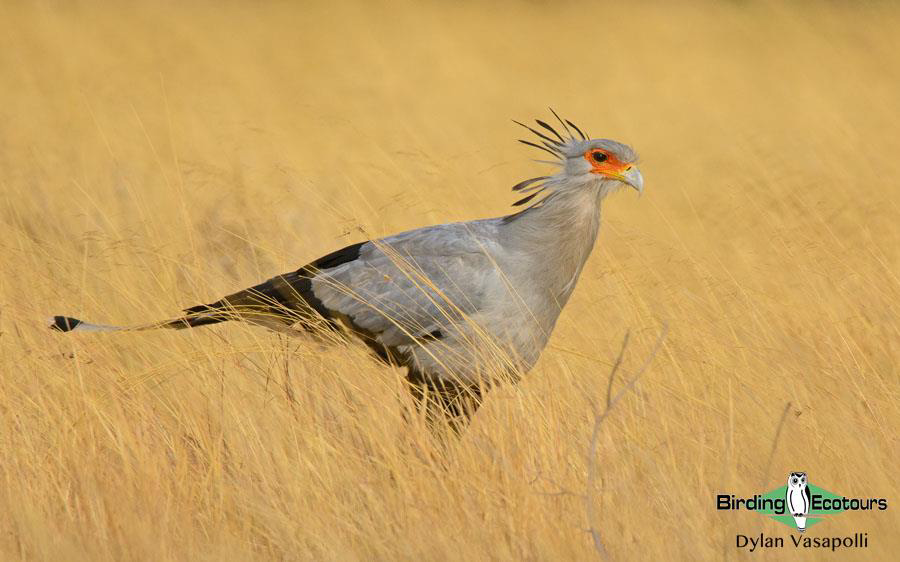
The bizarre Secretarybird was seen striding through the grasslands near Wakkerstroom town!
Day 11, 24th October 2024. Endemic birding around Wakkerstroom
We had a full day at our disposal for birding around Wakkerstroom, and were to make use of local guide, Lucky, for the day. Before heading out, we were treated to a feisty pair of Red-winged Francolins at our accommodation, running circles around us comically! After a flyby pair of Grey Crowned Cranes, we met up with Lucky and proceeded to bird the rolling green hills south of town. Birding in these high-altitude grasslands is very busy, and it was hard not to get distracted by the sheer abundance of birds and diversity of species! Magnificent Long-tailed Widowbirds were displaying everywhere, and the air was full of aerial feeders, mainly Greater Striped, White-throated and Barn Swallows and Banded, Brown-throated and Large Rock Martins. Other common birds in these grasslands included Cape Crow, Swainson’s Spurfowl, Crowned and Blacksmith Lapwings, Spur-winged Goose, Cape Longclaw, Cape and Pied Starling, African Pipit, Fan-tailed Widowbird, Red-capped Lark, Black-headed Heron, African Stonechat, Common Waxbill, and Wing-snapping, Zitting and Levaillant’s Cisticola. Isolated pools and farm dams along the roadside delivered African Spoonbill, Red-billed Teal, Cape Shoveler, Whiskered Tern, Red-billed Quelea, Southern Masked Weaver and Southern Red Bishop.
We made a stop on a rocky hillslope above the village of Groenvlei. Here we connected with Cape Canary, Cape Bunting, Mountain Chat and the endemic African Rock Pipit (a specialty of this habitat). Afterwards, we arrived at a nearby farm where, thanks to our guide, we were able to drive onto the property and ascend a picturesque grassy hill in search of our next targets. We parked atop the hill and walked around the fields for about two hours and ended up with a fantastic haul of species. The most noteworthy were a number of dazzling Yellow-breasted Pipits and, even rarer, a Rudd’s Lark. These two species are highly localized endemics of these high-altitude grasslands, and we were blessed to have gotten great views of both species. Numbers of Ant-eating Chats, Red-capped Larks and the charismatic Spike-heeled Lark made up the supporting cast, and a Blue Crane flyover was also enjoyable.
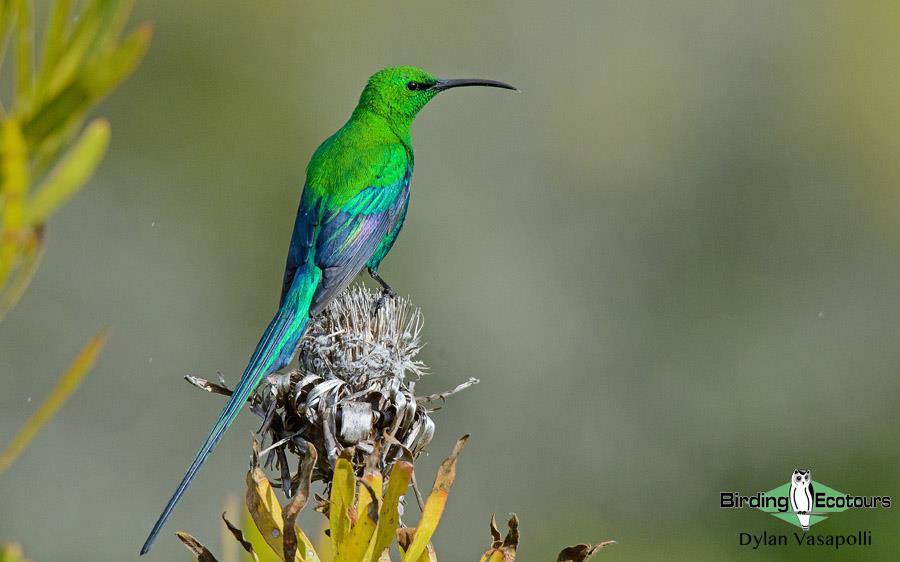
Among the greenest of all birds, the Malachite Sunbird is aptly named.
En route back to town, we made another stop on top of the hill above Wakkerstroom town. The rocky ground here gave us great views of Eastern Long-billed Lark, Mountain Chat, Buff-streaked Chat and another confiding pair of Red-winged Francolins. A Black Sparrowhawk diving on a Red-winged Starling above town was quite stunning. We then had lunch in town, after which we decided to head northeast towards the village of Dirkiesdorp. Various stops along the gravel backroads gave us a plethora of noteworthy sightings. These included the first bustards of the trip: first a male Black-bellied Bustard doing his strange popping display call next to the road. Next up was a trio of male Denham’s Bustards displaying on a distant hill, accompanied by a slightly closer female. Lastly, a pair of White-bellied Bustards (endemic subspecies barrowi) were trying their best to remain undetected by us, but ultimately failed! This route also gave us the bizarre Secretarybird and a breeding colony of South African Cliff Swallows under a small bridge. After some final great birds like Rock-loving Cisticola, Southern Bald Ibis, African Yellow Warbler, Quailfinch, Nicholson’s Pipit and African Black Swift, we made our way back to Wakkerstroom and said farewell to our fantastic guide, before returning home for another wonderful homecooked meal.
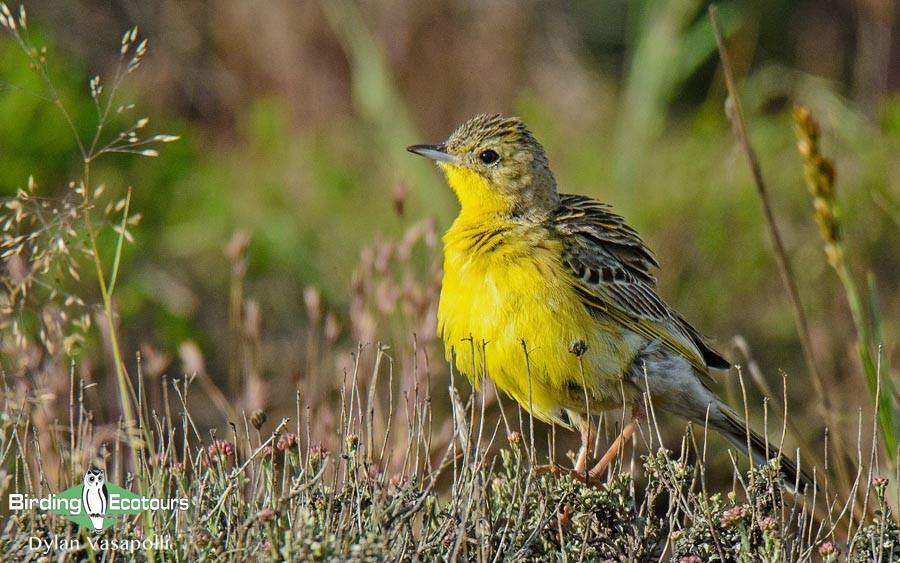
An Endangered, high-altitude grassland endemic, there’s lots to love about the handsome Yellow-breasted Pipit!
Day 12, 25th October 2024. Birding Wakkerstroom wetland, and transfer to the Kruger National Park
We made an early, pre-breakfast dash out into the grasslands to try clean up one or two species we had missed the previous day. The grasslands along the Amersfoort dirt road abounded with most of the afore-mentioned species, with the added splendor of two Blue Korhaans and a couple of pugnacious Pale-crowned Cisticolas. Targets secured, we made it back to the lodge in time for a splendid breakfast, before checking out and heading towards the bridge over the well-known Wakkerstroom wetland. This system of reedbeds, flooded grassland and open water hosts a variety of waterbird species, notable mentions we saw included Malachite Kingfisher, African Swamphen, Lesser Swamp Warbler and Little Rush Warbler.
After this, we left Wakkerstroom and started on the longest drive of the tour (6 hours) towards Kruger National Park. Not much new was seen along this drive, with South African Cliff Swallows, Common Buzzards and a single Long-crested Eagle being the only notable mentions. However, just before reaching the park at the grand Paul Kruger gate, we were treated to an immense Goliath Heron and two stately Saddle-billed Storks loafing along the Sabie River. Shortly after crossing through the gate into the park, our haste in reaching the camp was quickly halted by a pile of cars blocking the road. Knowing that this could only mean one thing, we rolled towards the crowd and swiftly realized what was causing the back-up: a Leopard lounging at eye-level next to the road. Only twenty minutes in the park and we had already bagged ourselves a big cat! We relished the sighting for as long as we could, before eventually arriving at Skukuza camp in time for dinner on the banks of the Sabie River. What a welcome to one of the best wildlife parks out there!
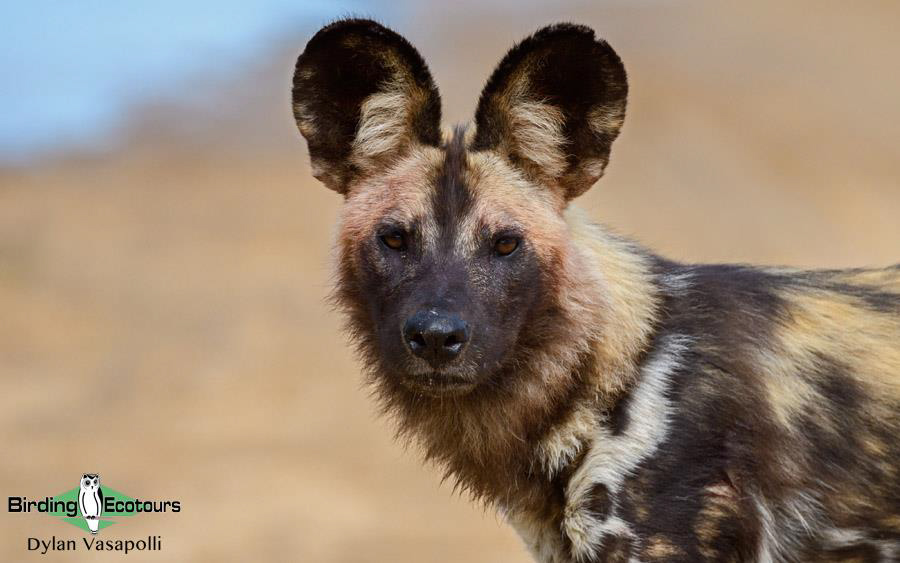
We managed to see the same pack of African Wild Dogs three times during our time in Kruger.
Day 13, 26th October 2024. Birding the famed Kruger National Park
Starting off our first full day in Kruger, the thickets around the camp were full of birds this morning, with the likes of Grey Go-away-bird, Black-collared Barbet, Black-headed Oriole, White-bellied Sunbird, Greater Blue-eared Starling, Blue Waxbill, Yellow-fronted Canary and African Hoopoe being quite common. We then piled into the safari vehicle and exited the camp gates into the park. Our excellent driver immediately took us to yet another Leopard that had been sighted along the same road we drove yesterday! This one was a bigger (and sleepier) individual than yesterday’s, so we left him in peace and proceeded towards Tshokwane picnic site. Common bushveld species along the drive included Emerald-spotted Wood Dove, Long-billed Crombec, Chinspot Batis, White-browed Scrub Robin, Yellow-breasted Apalis, Southern Black Tit, Black-backed Puffback, Orange-breasted Bushshrike, Rattling Cisticola, Fork-tailed Drongo, Tawny-flanked Prinia, Golden-breasted Bunting and Marico and White-bellied Sunbird. Such iconic safari birds as Magpie Shrike, Lilac-breasted Roller, African Grey Hornbill and Southern Yellow-billed Hornbill were also a feast for the eyes, as were the many blue starlings that seemed to cover the area. These were mostly Greater Blue-eared Starlings,but Cape Starling and the large Burchell’s Starling were also pretty common. The less colorful Wattled Starlings were less abundant but also around, as were Brown-crowned and Black-crowned Tchagra, Sabota Lark, Crested Barbet (pair seen excavating a nest hole), Cardinal Woodpecker and Black Cuckooshrike. Singletons of Levaillant’s Cuckoo, Cinnamon-breasted Bunting and a high-flying Black Stork were also great finds.
As we drove, we noticed lots of gamebirds along the roadside, which consisted of Helmeted Guineafowl, Crested Francolin and Natal and Swainson’s Spurfowl, while the bridge over the Sabie River delivered Grey Heron, Striated Heron, African Pied Wagtail, Wire-tailed Swallow, breeding Village and Lesser Masked Weavers, Common Hippopotamus and, best of all, four adorable Lion cubs! Kruger is as renowned for its abundance and diversity of raptor species as it is for its mammals. White-backed Vulture, Wahlberg’s and Tawny Eagle and the strangely shaped Bateleur were ever-present, with smaller numbers of African Fish Eagle, Brown Snake Eagle and Hooded Vulture also in evidence. On the note of big mammals, one of the top sightings of the day had to be a trio of female Lions taking down an Impala alongside the road in the Sabie riverbed. This was preceded by a family of African Wild Dogs trotting up the road right next to the car (a truly unforgettable sighting!). Other mammals seen included masses of African Savanna Elephant, Cape Buffalo, Impala, Southern Giraffe, Waterbuck, Plains Zebra, and smaller numbers of Nyala, Southern Bushbuck, Greater Kudu, Blue Wildebeest, Steenbok, Klipspringer, Common Warthog, Chacma Baboon, Smith’s Bush Squirrel, Common Dwarf Mongoose and Common Slender Mongoose.
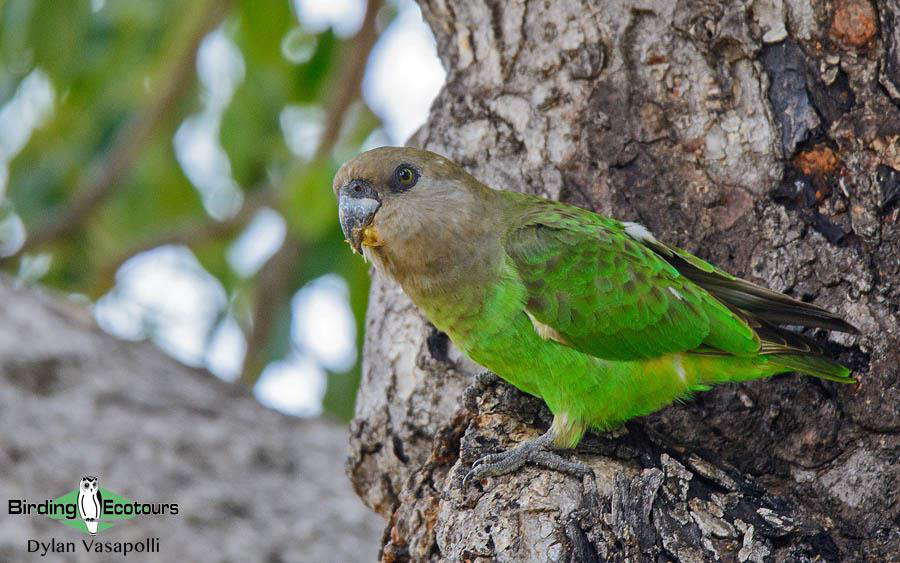
One of the few parrot species in South Africa, Brown-headed Parrot is a bird of savanna and riverine woodland.
Upon reaching Tshokwane, we had a scrumptious brunch at the deli, while being inundated with hungry Greater Blue-eared and Cape Starlings looking for scraps. These were accompanied by Laughing and Mourning Collared Doves (the latter a localized species in South Africa). We then walked around the picnic site where, after a bit of coaxing, we found a bustling mixed species foraging flock. These included a lot of the afore-mentioned species, with the addition of Green Wood Hoopoe, Common Scimitarbill, Brown-hooded Kingfisher, Common Reed Warbler, Spectacled Weaver, Terrestrial Brownbul, Arrow-marked Babbler, Scarlet-chested Sunbird and Kurrichane Thrush. Soon thereafter, the reason for all the chaos materialized, in the form of a Pearl-spotted Owlet, which provided stunning views before disappearing into the bush, taking its entourage of mobsters with it. Meanwhile, birding along the river in front of the picnic site delivered Red-faced Cisticola, African Paradise Flycatcher, Black, Crake, Black-winged Stilt, African Jacana, Wood and Common Sandpiper, Pied and Giant Kingfisher, Three-banded Plover and an overflying Sand Martin amidst the abundant Barn Swallows.
We then headed back towards Skukuza after brunch, adding a handful of great sightings and new species to the trip list. These included Purple Roller, Southern White-crowned Shrike, Grey-headed Bushshrike, White-fronted Bee-eater, Grey Penduline Tit, a flyby Shikra,two sightings of White-headed Vulture,a Common Hippopotamus walking out in broad daylight and a loafing White Rhinoceros near the camp gate (the latter completing our “Big 5 in one day” achievement). Arriving back at Skukuza in the late afternoon, we took the time to relax before dinner. The birding around the camp itself was enough to fill in the time, most notable were a singing African Goshawk, a flock of African Green Pigeons in a fruiting fig tree and a pair of African Black Ducks on the river in front of the restaurant. After dinner, most of the group went on a night drive which turned out to be quite rewarding. Over the two hour drive, we spotted a sleeping Leopard being harassed by a lone Spotted Hyena, the same group of African Wild Dogs that we had seen earlier (now snuggled up under a bush), two more groups of Spotted Hyena, two Rusty-spotted Genets, a Cape Porcupine, a Verreaux’s Eagle-Owl, a roosting Marabou Stork and, my personal highlight, a White-tailed Mongoose. This finished off an astounding day in Kruger, and probably my best day of game-viewing ever!
Day 13, 26th October 2024. Birding the famed Kruger National Park, part 2
On our second day of Kruger exploration, we decided to head south this time, towards Lower Sabie. Following the river for most of the day turned out to be a good call, as today turned out to be very hot and sunny, contrasting with the comfortable cloudy weather we had the previous day. Nonetheless, we made the most of it and ended up with an impressive species list for the day. We had seen most of these the previous day, but new additions included Purple Heron, Red-billed and Jameson’s Firefinch, Green-winged Pytilia, noisy Brown-headed Parrots,a single Mosque Swallow, a group of Retz’s Helmetshrike and, along the river, the handsome White-crowned Lapwing. Among the less common species seen, were Collared Pratincole (breeding on the river), Grey Tit-Flycatcher, Ashy Flycatcher, Trumpeter Hornbill, Spectacled Weaver, Hamerkop, Golden-tailed Woodpecker, African Woolly-necked and Saddle-billed Storks,and a surprise Cape Vulture. At one point we chanced upon a truly gargantuan herd of Cape Buffalo, at least 500 strong! Understandably, they were adorned with flocks of Red-billed Oxpeckers, which we saw on most of the big game in Kruger. However, upon careful inspection, we managed to pick out a handful of the scarcer Yellow-billed Oxpecker, not a common bird this far south.
We arrived at Lower Sabie just in time for lunch, once again overlooking the immense Sabie River. The respite from the heat was welcome, and we made sure to take our time and enjoy the vista from the restaurant deck. A nearby fountain attracted birds that were also seeking relief from the heat. These included White-browed Robin-Chat, Green-backed Camaroptera, Violet-backed Starling, Terrestrial Brownbul, African Paradise Flycatcher and Lesser Masked Weaver. Over the river, an African Fish Eagle gave us some close flybys, along with flocks of African Palm, Little and White-rumped Swifts and Lesser Striped Swallows. Once revitalized by our break, we left the camp and headed back towards Skukuza, stopping briefly at Sunset Dam on the way out of Lower Sabie. Here we found several waders, namely Wood, Common and Marsh Sandpipers, as well as White-fronted Bee-eater, African Openbill, Yellow-billed Stork and African Spoonbill. The rest of the journey back didn’t deliver much, but multiple close views of perched African Fish Eagles were enjoyed, as was another distant Lion pride. Once back at Skukuza, we bid farewell to our safari driver and relaxed for the rest of the evening, before having dinner and being serenaded by a pair of African Wood Owls from the camping area.

We had multiple Lion sightings during our two days in Kruger.
Day 15, 28th October 2024. Birding Skukuza and transfer to Dullstroom, birding en route
We had a more leisurely morning today, taking time for a birding stroll around camp, before having a sit-down breakfast at the restaurant. African Green Pigeon, Water Thick-knee, Great Egret, Purple-crested Turaco and a stunning Goliath Heron were all enjoyed along the river, while a Crowned Hornbill, two overflying Brown-headed Parrots and a brief Western House Martin were notable. After breakfast, we packed up (back into the tour van this time) and left Skukuza, heading south towards Malelane gate. Driving through the heat of the late morning, the birding was slow going, but we did manage to find our first Southern Red-billed Hornbills of the trip, as well as another Cinnamon-breasted Bunting and the uncommon Stierling’s Wren-Warbler. Once we crossed through Malelane gate, we stopped on the bridge over the Crocodile River where the birding was much more prolific. We had great views of many previously mentioned waterbirds, with the addition of a pair of African Skimmers roosting on the sandbars in the river. This iconic bird is a vagrant to South Africa but has been becoming more regular over the years and is now a rare annual breeder in places like Kruger. This pair has been returning for many years now. After enjoying the skimmers and two male Greater Honeyguides having a scuffle nearby, we left Kruger and set out on the long drive towards Dullstroom, leaving the hot, humid lowlands behind and once again ascending into the cool montane grasslands of the eastern interior of South Africa.
Day 16, 29th October 2024. Birding Dullstroom, and transfer to Dinokeng, birding en route
We decided to have a later start today and another leisurely morning, before heading towards our final destination of the tour. The birds around our chalets kept us entertained while we had our coffee, with Purple Heron, African Wattled Lapwing, Malachite Sunbird, Cape Weaver and a showy Bokmakierie all in evidence. Once we were packed up and on the road, we made our way back down the gravel access tracktowards the main road, where we witnessed large groups of African Olive Pigeons flying between the tree rows on the roadside farms. Streaky-headed Seedeater, Banded Martin, Cape Canary, European Bee-eater and Drakensberg Prinia were all seen before reaching the main tarred road. We then went into the quaint holiday town of Dullstroom, where we had yet another delicious sit-down breakfast and then made tracks west towards Pretoria and, ultimately, Dinokeng Game Reserve: our last base on the tour.
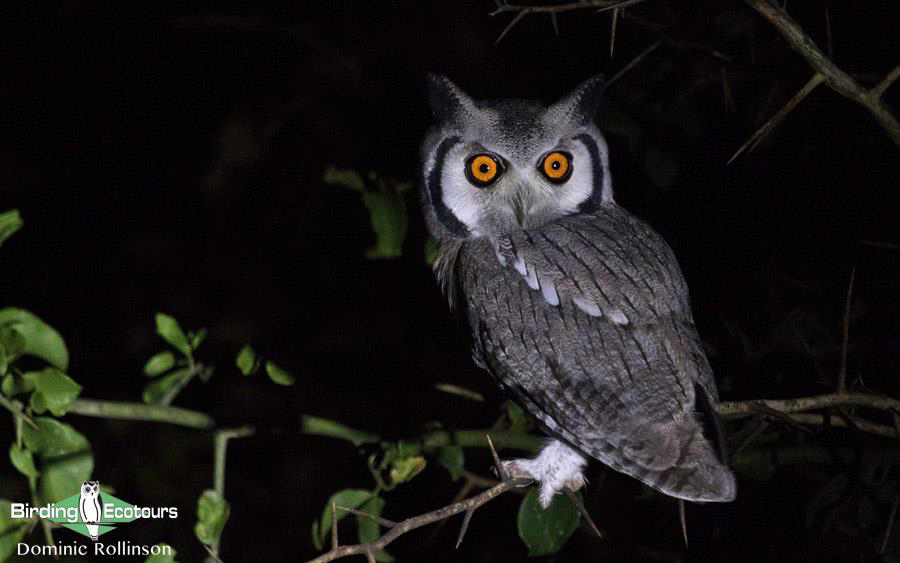
We managed to see two Southern White-faced Owls in Dinokeng, with others calling around us.
We arrived at our comfortable safari lodge in the afternoon. Set amidst mixed woodland and Acacia savanna, the birding in this region was quite reminiscent of Kruger, but with a noticeable influence from the Kalahari (much drier than Kruger). With the intense heat beating down on us once again, we took the rest of the afternoon off and enjoyed the bird activity around the lodge. From our lunch table we managed to see African Wattled Lapwing, Southern Red-billed and Southern Yellow-billed Hornbill, Burchell’s Starling, Groundscraper Thrush, Southern Black Flycatcher, Brubru, Willow Warbler, Golden-tailed and Cardinal Woodpecker and a fly-by Gabar Goshawk. After a lengthy period of relaxation and a hearty dinner, we went for a short night drive down one of the gravel roads north of the lodge. A few meters down the road and 45 minutes later, we had bagged at least two Southern White-faced Owls (more calling in the vicinity), as well as both Rufous-cheeked and Fiery-necked Nightjars. Add on a calling Pearl-spotted Owlet and this made for the best session of night birding on the whole tour!
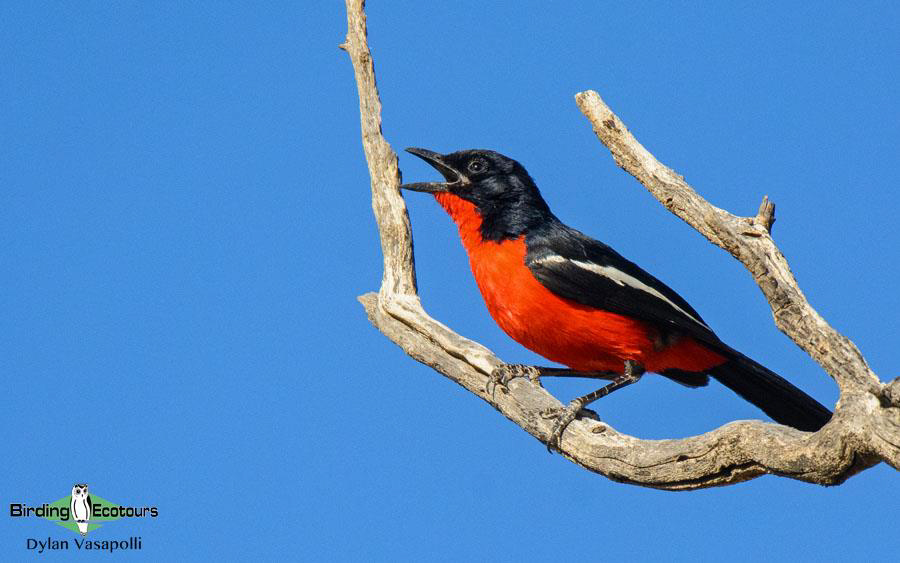
The bright and charismatic Crimson-breasted Shrike was among the last highlights of the tour.
Day 17, 30th October 2024. Birding the Zaagkuilsdrift Road and Kgomo-Kgomo
Our main objective this morning was to bird the famous 24-kilometer dirt road between the villages of Zaagkuilsdrift and Kgomo-Kgomo. This arbitrary track is well-known in local birding circles for the sheer abundance of species that can be found along it. The combination of dense Acacia thickets, short grassy plains and the nearby Pienaars River floodplain contribute to this diversity. The agricultural fields at the start of the track yielded several stunning Northern Black Korhaans, as well as Buffy Pipit. Shortly after this, the road entered the Acacia thickets which, as usual, were quite productive. It did not take long for us to start collecting some of the Kalahari specials found in this habitat, such as Black-chested Prinia, White-browed Sparrow-Weaver, Chestnut-vented Warbler, Southern Pied Babbler, Grey-backed Camaroptera and the vivid Crimson-breasted Shrike. Other Acacia-loving species seen along this first section of the road included Burnt-necked Eremomela, Blue Waxbill, Orange-breasted Bushshrike, Brubru, Burchell’s Starling, Green Wood Hoopoe, Southern Red-billed and Southern Yellow-billed Hornbill, Acacia Pied Barbet, White-bellied Sunbird, Crested Francolin, the ubiquitous Magpie Shrike and a trio of Red-billed Buffalo Weavers.
Further along, the thickets gave way to open grassy patches that were full of Crowned and African Wattled Lapwings, while the roadside game fence gave great views of a few Pearl-breasted Swallows, our final hirundine of the trip. An adorable Pearl-spotted Owlet showed quite well too, despite the mob of small birds harassing it! We also managed to pick out the near-endemic Marico Flycatcher from amongst the more common Spotted Flycatchers. By mid-morning it was already unbearably hot, so we decided to cut our losses and head straight to the western end of the road at Kgomo-Kgomo. Here, the flats surrounding the dry floodplain played host to a few handsome Capped Wheatears, while the scrub surrounding the adjacent village got us a Jacobin Cuckoo, the miniscule Cape Penduline Tit and a singing Barred Wren-Warbler. With our final handful of species in the bag, we departed from Kgomo-Kgomo and headed back towards our lodge in Dinokeng, but not without some lovely Namaqua Doves on the telephone lines to distract us.
Once again, we spent the rest of the scorching afternoon at the lodge, with plenty of bird activity to keep us entertained. A tame party of Arrow-marked Babblers was a notable addition to yesterday’s entourage of species, and we even managed to call in a Yellow-fronted Tinkerbird while having lunch. We did end up taking a short drive to Fischer Dam next to the lodge, which gave us more good views of afore-mentioned species, such as Golden-tailed Woodpecker, Burchell’s Coucal, Lesser Striped and White-throated Swallow, African Darter, Reed Cormorant, African Jacana and Great Egret.
Day 18, 31st October 2024. Birding urban Gauteng, and departure from Johannesburg
For the final morning of the tour, we once again had a later start and enjoyed a sit-down breakfast while continuing to enjoy the birds on the lodge grounds. Kurrichane Thrush, Red-headed Weaver, Marico Sunbird, Neddicky and Burnt-necked Eremomela were some of the notable mentions. After breakfast, we packed up the van for the last time and left the lodge. Before we left the reserve however, we did manage to connect with a showy Kalahari Scrub Robin and got brief views of a Red-crested Korhaan. Once we had left the reserve, we made a beeline for Johannesburg, with stops for lunch and a midday birding break at two different pans on the city outskirts. The first one was at Korsman Bird Sanctuary, where we finally managed to find flamingos! Both Greater and Lesser Flamingos were on show here, as well as Southern Pochard,amongst the more common waterbird species. The second pan, known as Bullfrog Pan, turned up some distant Maccoa Ducks,a close-by Blue-billed Teal and more Southern Pochards,while a male Diederik Cuckoo and a group of Green Wood Hoopoes rang out from the adjacent gardens. These would be our last new species for the trip, after which we settled down for one final lunch together as a group. We then made our way to the OR Tambo International Airport in Johannesburg, where the tour concluded.
Many thanks to all the tour participants for making this another unforgettable Subtropical South Africa Tour! With over 400 species seen and a plethora of good mammals, this tour was definitely one to remember.
Bird List – Following IOC Version 15.1 (February 2025)
Birds ‘heard only’ are marked with (H) after the common name, all other species were seen.
The following notation after species names is used to show conservation status following the IUCN Red List:
CR = Critically Endangered, EN = Endangered, VU = Vulnerable.
| Common name | Scientific name |
| Ostriches (Struthionidae) | |
| Common Ostrich | Struthio camelus |
| Ducks, Geese, Swans (Anatidae) | |
| White-faced Whistling Duck | Dendrocygna viduata |
| Fulvous Whistling Duck | Dendrocygna bicolor |
| White-backed Duck | Thalassornis leuconotus |
| Spur-winged Goose | Plectropterus gambensis |
| Egyptian Goose | Alopochen aegyptiaca |
| South African Shelduck | Tadorna cana |
| African Pygmy Goose | Nettapus auritus |
| Blue-billed Teal | Spatula hottentota |
| Cape Shoveler | Spatula smithii |
| African Black Duck | Anas sparsa |
| Yellow-billed Duck | Anas undulata |
| Red-billed Teal | Anas erythrorhyncha |
| Southern Pochard | Netta erythrophthalma |
| Maccoa Duck – EN | Oxyura maccoa |
| Guineafowl (Numididae) | |
| Helmeted Guineafowl | Numida meleagris |
| Southern Crested Guineafowl | Guttera edouardi |
| Pheasants & Allies (Phasianidae) | |
| Crested Francolin | Ortygornis sephaena |
| Red-winged Francolin | Scleroptila levaillantii |
| Grey-winged Francolin | Scleroptila afra |
| Natal Spurfowl | Pternistis natalensis |
| Swainson’s Spurfowl | Pternistis swainsonii |
| Nightjars (Caprimulgidae) | |
| Rufous-cheeked Nightjar | Caprimulgus rufigena |
| Fiery-necked Nightjar | Caprimulgus pectoralis |
| Swifts (Apodidae) | |
| African Palm Swift | Cypsiurus parvus |
| Alpine Swift | Tachymarptis melba |
| African Black Swift | Apus barbatus |
| Little Swift | Apus affinis |
| White-rumped Swift | Apus caffer |
| Turacos (Musophagidae) | |
| Grey Go-away-bird | Crinifer concolor |
| Purple-crested Turaco | Gallirex porphyreolophus |
| Livingstone’s Turaco | Tauraco livingstonii |
| Knysna Turaco (H) | Tauraco corythaix |
| Bustards (Otididae) | |
| Denham’s Bustard | Neotis denhami |
| White-bellied Bustard | Eupodotis senegalensis |
| Blue Korhaan | Eupodotis caerulescens |
| Red-crested Korhaan (H) | Lophotis ruficrista |
| Northern Black Korhaan | Afrotis afraoides |
| Black-bellied Bustard | Lissotis melanogaster |
| Cuckoos (Cuculidae) | |
| Burchell’s Coucal | Centropus burchellii |
| Green Malkoha | Ceuthmochares australis |
| Great Spotted Cuckoo (H) | Clamator glandarius |
| Levaillant’s Cuckoo | Clamator levaillantii |
| Jacobin Cuckoo | Clamator jacobinus |
| Diederik Cuckoo | Chrysococcyx caprius |
| Klaas’s Cuckoo | Chrysococcyx klaas |
| African Emerald Cuckoo | Chrysococcyx cupreus |
| Black Cuckoo | Cuculus clamosus |
| Red-chested Cuckoo | Cuculus solitarius |
| Pigeons, Doves (Columbidae) | |
| Rock Dove | Columba livia |
| Speckled Pigeon | Columba guinea |
| African Olive Pigeon | Columba arquatrix |
| Lemon Dove | Columba larvata |
| Mourning Collared Dove | Streptopelia decipiens |
| Red-eyed Dove | Streptopelia semitorquata |
| Ring-necked Dove | Streptopelia capicola |
| Laughing Dove | Spilopelia senegalensis |
| Emerald-spotted Wood Dove | Turtur chalcospilos |
| Tambourine Dove | Turtur tympanistria |
| Namaqua Dove | Oena capensis |
| African Green Pigeon | Treron calvus |
| Flufftails & Forest Rails (Sarothruridae) | |
| Buff-spotted Flufftail (H) | Sarothrura elegans |
| Rails, Crakes & Coots (Rallidae) | |
| Common Moorhen | Gallinula chloropus |
| Red-knobbed Coot | Fulica cristata |
| African Swamphen | Porphyrio madagascariensis |
| Black Crake | Zapornia flavirostra |
| Cranes (Gruidae) | |
| Grey Crowned Crane – EN | Balearica regulorum |
| Wattled Crane – VU | Grus carunculata |
| Blue Crane – VU | Grus paradisea |
| Grebes (Podicipedidae) | |
| Little Grebe | Tachybaptus ruficollis |
| Flamingos (Phoenicopteridae) | |
| Greater Flamingo | Phoenicopterus roseus |
| Lesser Flamingo | Phoeniconaias minor |
| Stone-curlews, Thick-knees (Burhinidae) | |
| Spotted Thick-knee | Burhinus capensis |
| Water Thick-knee | Burhinus vermiculatus |
| Oystercatchers (Haematopodidae) | |
| African Oystercatcher | Haematopus moquini |
| Stilts, Avocets (Recurvirostridae) | |
| Black-winged Stilt | Himantopus himantopus |
| Pied Avocet | Recurvirostra avosetta |
| Plovers (Charadriidae) | |
| Grey Plover | Pluvialis squatarola |
| Common Ringed Plover | Charadrius hiaticula |
| Three-banded Plover | Charadrius tricollaris |
| Blacksmith Lapwing | Vanellus armatus |
| White-crowned Lapwing | Vanellus albiceps |
| Senegal Lapwing | Vanellus lugubris |
| Black-winged Lapwing | Vanellus melanopterus |
| Crowned Lapwing | Vanellus coronatus |
| African Wattled Lapwing | Vanellus senegallus |
| Kittlitz’s Plover | Anarhynchus pecuarius |
| White-fronted Plover | Anarhynchus marginatus |
| Jacanas (Jacanidae) | |
| African Jacana | Actophilornis africanus |
| Sandpipers, Snipes (Scolopacidae) | |
| Eurasian Whimbrel | Numenius phaeopus |
| Common Sandpiper | Actitis hypoleucos |
| Marsh Sandpiper | Tringa stagnatilis |
| Wood Sandpiper | Tringa glareola |
| Common Greenshank | Tringa nebularia |
| Ruff | Calidris pugnax |
| Little Stint | Calidris minuta |
| Coursers, Pratincoles (Glareolidae) | |
| Collared Pratincole | Glareola pratincola |
| Gulls, Terns, Skimmers (Laridae) | |
| African Skimmer | Rynchops flavirostris |
| Caspian Tern | Hydroprogne caspia |
| Common Tern | Sterna hirundo |
| Whiskered Tern | Chlidonias hybrida |
| Greater Crested Tern | Thalasseus bergii |
| Grey-headed Gull | Chroicocephalus cirrocephalus |
| Storks (Ciconiidae) | |
| African Openbill | Anastomus lamelligerus |
| Marabou Stork | Leptoptilos crumenifer |
| Yellow-billed Stork | Mycteria ibis |
| Saddle-billed Stork | Ephippiorhynchus senegalensis |
| African Woolly-necked Stork | Ciconia microscelis |
| Black Stork | Ciconia nigra |
| Anhingas, Darters (Anhingidae) | |
| African Darter | Anhinga rufa |
| Cormorants, Shags (Phalacrocoracidae) | |
| Reed Cormorant | Microcarbo africanus |
| White-breasted Cormorant | Phalacrocorax lucidus |
| Ibises, Spoonbills (Threskiornithidae) | |
| African Sacred Ibis | Threskiornis aethiopicus |
| Southern Bald Ibis – VU | Geronticus calvus |
| Hadada Ibis | Bostrychia hagedash |
| Glossy Ibis | Plegadis falcinellus |
| African Spoonbill | Platalea alba |
| Herons, Bitterns (Ardeidae) | |
| Little Bittern | Ixobrychus minutus |
| Black-crowned Night Heron | Nycticorax nycticorax |
| Black Heron | Egretta ardesiaca |
| Little Egret | Egretta garzetta |
| Little Heron | Butorides atricapilla |
| Rufous-bellied Heron | Ardeola rufiventris |
| Squacco Heron | Ardeola ralloides |
| Great Egret | Ardea alba |
| Yellow-billed Egret | Ardea brachyrhyncha |
| Western Cattle Egret | Bubulcus ibis |
| Grey Heron | Ardea cinerea |
| Purple Heron | Ardea purpurea |
| Black-headed Heron | Ardea melanocephala |
| Goliath Heron | Ardea goliath |
| Hamerkop (Scopidae) | |
| Hamerkop | Scopus umbretta |
| Pelicans (Pelecanidae) | |
| Great White Pelican | Pelecanus onocrolatus |
| Pink-backed Pelican | Pelecanus rufescens |
| Secretarybird (Sagittariidae) | |
| Secretarybird – EN | Sagittarius serpentarius |
| Kites, Hawks, Eagles (Accipitridae) | |
| Black-winged Kite | Elanus caeruleus |
| African Harrier-Hawk | Polyboroides typus |
| Palm-nut Vulture | Gypohierax angolensis |
| Bearded Vulture | Gypaetus barbatus |
| African Cuckoo-Hawk | Aviceda cuculoides |
| Hooded Vulture – CR | Necrosyrtes monachus |
| White-backed Vulture – CR | Gyps africanus |
| Cape Vulture – VU | Gyps coprotheres |
| White-headed Vulture – CR | Trigonoceps occipitalis |
| Black-chested Snake Eagle | Circaetus pectoralis |
| Brown Snake Eagle | Circaetus cinereus |
| Southern Banded Snake Eagle | Circaetus fasciolatus |
| Bateleur – EN | Terathopius ecaudatus |
| Crowned Eagle | Stephanoaetus coronatus |
| Martial Eagle – EN | Polemaetus bellicosus |
| Long-crested Eagle | Lophaetus occipitalis |
| Wahlberg’s Eagle | Hieraaetus wahlbergi |
| Tawny Eagle – VU | Aquila rapax |
| Verreaux’s Eagle | Aquila verreauxii |
| Gabar Goshawk | Micronisus gabar |
| Dark Chanting Goshawk | Melierax metabates |
| African Goshawk | Aerospiza tachiro |
| Shikra | Tachyspiza tachiro |
| Black Sparrowhawk | Astur melanoleucus |
| African Marsh Harrier | Circus ranivorus |
| Yellow-billed Kite | Milvus aegyptius |
| African Fish Eagle | Icthyophaga vocifer |
| Common Buzzard | Buteo buteo |
| Jackal Buzzard | Buteo rufofuscus |
| Owls (Strigidae) | |
| Pearl-spotted Owlet | Glaucidium perlatum |
| African Scops-Owl (H) | Otus senegalensis |
| Southern White-faced Owl | Ptilopsis granti |
| Spotted Eagle-Owl | Bubo africanus |
| Verreaux’s Eagle-Owl | Ketupa lactea |
| African Wood Owl | Strix woodfordii |
| Mousebirds (Coliidae) | |
| Speckled Mousebird | Colius striatus |
| Red-faced Mousebird | Urocolius indicus |
| Trogons (Trogonidae) | |
| Narina Trogon | Apaloderma narina |
| Hoopoes (Upupidae) | |
| African Hoopoe | Upupa africana |
| Wood Hoopoes (Phoeniculidae) | |
| Green Wood Hoopoe | Phoeniculus purpureus |
| Common Scimitarbill | Rhinopomastus cyanomelas |
| Hornbills (Bucerotidae) | |
| Southern Red-billed Hornbill | Tockus rufirostris |
| Southern Yellow-billed Hornbill | Tockus leucomelas |
| Crowned Hornbill | Lophoceros alboterminatus |
| African Grey Hornbill | Lophoceros nasutus |
| Trumpeter Hornbill | Bycanistes bucinator |
| Rollers (Coraciidae) | |
| Purple Roller | Coracias naevius |
| Lilac-breasted Roller | Coracias caudatus |
| Broad-billed Roller | Eurystomus glaucurus |
| Kingfishers (Alcedinidae) | |
| Brown-hooded Kingfisher | Halcyon albiventris |
| Striped Kingfisher | Halcyon chelicuti |
| African Pygmy Kingfisher | Ispidina picta |
| Malachite Kingfisher | Corythornis cristatus |
| Giant Kingfisher | Megaceryle maxima |
| Pied Kingfisher | Ceryle rudis |
| Bee-eaters (Meropidae) | |
| Little Bee-eater | Merops pusillus |
| White-fronted Bee-eater | Merops bullockoides |
| European Bee-eater | Merops apiaster |
| African Barbets (Lybiidae) | |
| Crested Barbet | Trachyphonus vaillantii |
| Green Barbet | Stactolaema olivacea |
| White-eared Barbet | Stactolaema leucotis |
| Yellow-rumped Tinkerbird | Pogoniulus bilineatus |
| Southern Red-fronted Tinkerbird | Pogoniulus pusillus |
| Yellow-fronted Tinkerbird | Pogoniulus chrysoconus |
| Acacia Pied Barbet | Tricholaema leucomelas |
| Black-collared Barbet | Lybius torquatus |
| Honeyguides (Indicatoridae) | |
| Lesser Honeyguide | Indicator minor |
| Scaly-throated Honeyguide | Indicator variegatus |
| Greater Honeyguide | Indicator indicator |
| Woodpeckers (Picidae) | |
| Red-throated Wryneck | Jynx ruficollis |
| Ground Woodpecker | Geocolaptes olivaceus |
| Golden-tailed Woodpecker | Campethera abingoni |
| Cardinal Woodpecker | Dendropicos fuscescens |
| Olive Woodpecker | Dendropicos griseocephalus |
| Caracaras, Falcons (Falconidae) | |
| Rock Kestrel | Falco rupicolus |
| Lanner Falcon | Falco biarmicus |
| African & New World Parrots (Psittacidae) | |
| Brown-headed Parrot | Poicephalus cryptoxanthus |
| Wattle-eyes, Batises (Platysteiridae) | |
| Cape Batis | Batis capensis |
| Woodwards’ Batis | Batis fratrum |
| Chinspot Batis | Batis molitor |
| Black-throated Wattle-eye | Platysteira peltata |
| Bushshrikes (Malaconotidae) | |
| Grey-headed Bushshrike | Malaconotus blanchoti |
| Olive Bushshrike | Chlorophoneus olivaceus |
| Orange-breasted Bushshrike | Chlorophoneus sulfureopectus |
| Gorgeous Bushshrike | Telophorus viridis |
| Bokmakierie | Telophorus zeylonus |
| Brown-crowned Tchagra | Tchagra australis |
| Southern Tchagra | Tchagra tchagra |
| Black-crowned Tchagra | Tchagra senegalus |
| Black-backed Puffback | Dryoscopus cubla |
| Southern Boubou | Laniarius ferrugineus |
| Crimson-breasted Shrike | Laniarius atrococcineus |
| Brubru | Nilaus afer |
| Vangas & Allies (Vangidae) | |
| Retz’s Helmetshrike | Prionops retzii |
| Cuckooshrikes (Campephagidae) | |
| Grey Cuckooshrike | Ceblepyris caesius |
| Black Cuckooshrike | Campephaga flava |
| Figbirds, Old World Orioles, Piopios (Oriolidae) | |
| Black-headed Oriole | Oriolus larvatus |
| Drongos (Dicruridae) | |
| Fork-tailed Drongo | Dicrurus adsimilis |
| Square-tailed Drongo | Dicrurus ludwigii |
| Monarchs (Monarchidae) | |
| Blue-mantled Crested Flycatcher | Trochocercus cyanomelas |
| African Paradise Flycatcher | Terpsiphone viridis |
| Shrikes (Laniidae) | |
| Southern White-crowned Shrike | Eurocephalus anguitimens |
| Magpie Shrike | Lanius melanoleucus |
| Southern Fiscal | Lanius collaris |
| Crows, Jays (Corvidae) | |
| Cape Crow | Corvus capensis |
| Pied Crow | Corvus albus |
| White-necked Raven | Corvus albicollis |
| Rockjumpers (Chaetopidae) | |
| Drakensberg Rockjumper | Chaetops aurantius |
| Fairy Flycatchers (Stenostiridae) | |
| Fairy Flycatcher | Stenostira scita |
| Tits, Chickadees (Paridae) | |
| Southern Black Tit | Melaniparus niger |
| Penduline Tits (Remizidae) | |
| Grey Penduline Tit | Anthoscopus caroli |
| Cape Penduline Tit | Anthoscopus minutus |
| Nicators (Nicatoridae) | |
| Eastern Nicator | Nicator gularis |
| Larks (Alaudidae) | |
| Spike-heeled Lark | Chersomanes albofasciata |
| Eastern Long-billed Lark | Certhilauda semitorquata |
| Sabota Lark | Calendulauda sabota |
| Rudd’s Lark – EN | Heteromirafra ruddi |
| Rufous-naped Lark | Mirafra africana |
| Large-billed Lark | Galerida magnirostris |
| Red-capped Lark | Calandrella cinerea |
| Bulbuls (Pycnonotidae) | |
| Sombre Greenbul | Andropadus importunus |
| Yellow-bellied Greenbul | Chlorocichla flaviventris |
| Terrestrial Brownbul | Phyllastrephus terrestris |
| Yellow-streaked Greenbul | Phyllastrephus flavostriatus |
| Dark-capped Bulbul | Pycnonotus tricolor |
| Swallows, Martins (Hirundinidae) | |
| Black Saw-wing | Psalidoprocne pristoptera |
| Banded Martin | Neophedina cincta |
| Brown-throated Martin | Riparia paludicola |
| Large Rock Martin | Ptyonoprogne fuligula |
| Blue Swallow – VU | Hirundo atrocaerulea |
| Pearl-breasted Swallow | Hirundo dimidiata |
| Barn Swallow | Hirundo rustica |
| White-throated Swallow | Hirundo albigularis |
| Wire-tailed Swallow | Hirundo smithii |
| Western House Martin | Delichon urbicum |
| Greater Striped Swallow | Cecropis cucullata |
| Lesser Striped Swallow | Cecropis abyssinica |
| Red-breasted Swallow | Cecropis semirufa |
| Mosque Swallow | Cecropis senegalensis |
| South African Cliff Swallow | Petrochelidon spilodera |
| Crombecs, African Warblers (Macrosphenidae) | |
| Cape Grassbird | Sphenoeacus afer |
| Long-billed Crombec | Sylvietta rufescens |
| Leaf Warblers (Phylloscopidae) | |
| Willow Warbler | Phylloscopus trochilus |
| Reed Warblers & Allies (Acrocephalidae) | |
| Lesser Swamp Warbler | Acrocephalus gracilirostris |
| Common Reed Warbler | Acrocephalus scirpaceus |
| African Yellow Warbler | Iduna natalensis |
| Grassbirds & Allies (Locustellidae) | |
| Barratt’s Warbler | Bradypterus barratti |
| Little Rush Warbler | Bradypterus baboecala |
| Cisticolas & Allies (Cisticolidae) | |
| Red-faced Cisticola | Cisticola erythrops |
| Lazy Cisticola | Cisticola aberrans |
| Rattling Cisticola | Cisticola chiniana |
| Wailing Cisticola | Cisticola lais |
| Rufous-winged Cisticola | Cisticola galactotes |
| Levaillant’s Cisticola | Cisticola tinniens |
| Croaking Cisticola | Cisticola natalensis |
| Neddicky | Cisticola fulvicapilla |
| Zitting Cisticola | Cisticola juncidis |
| Pale-crowned Cisticola | Cisticola cinnamomeus |
| Wing-snapping Cisticola | Cisticola ayresii |
| Tawny-flanked Prinia | Prinia subflava |
| Black-chested Prinia | Prinia flavicans |
| Karoo Prinia | Prinia maculosa |
| Drakensberg Prinia | Prinia hypoxantha |
| Bar-throated Apalis | Apalis thoracica |
| Rudd’s Apalis | Apalis ruddi |
| Yellow-breasted Apalis | Apalis flavida |
| Green-backed Camaroptera | Camaroptera brachyura |
| Grey-backed Camaroptera (H) | Camaroptera brevicaudata |
| Stierling’s Wren-Warbler | Calamonastes stierlingi |
| Barred Wren-Warbler | Calamonastes fasciolatus |
| Burnt-necked Eremomela | Eremomela usticollis |
| Sylviid Babblers (Sylviidae) | |
| Bush Blackcap – VU | Sylvia nigricapillus |
| Layard’s Warbler | Curruca layardi |
| Chestnut-vented Warbler | Curruca subcoerulea |
| White-eyes (Zosteropidae) | |
| Cape White-eye | Zosterops virens |
| Laughingthrushes & Allies (Leiothrichidae) | |
| Arrow-marked Babbler | Turdoides jardineii |
| Southern Pied Babbler | Turdoides bicolor |
| Sugarbirds (Promeropidae) | |
| Gurney’s Sugarbird | Promerops gurneyi |
| Starlings, Rhabdornises (Sturnidae) | |
| Common Myna | Acridotheres tristis |
| Common Starling | Sturnus vulgaris |
| Wattled Starling | Creatophora cinerea |
| Black-bellied Starling | Notopholia corusca |
| Cape Starling | Lamprotornis nitens |
| Greater Blue-eared Starling | Lamprotornis chalybaeus |
| Burchell’s Starling | Lamprotornis australis |
| Pied Starling | Lamprotornis bicolor |
| Violet-backed Starling | Cinnyricinclus leucogaster |
| Red-winged Starling | Onychognathus morio |
| Oxpeckers (Buphagidae) | |
| Yellow-billed Oxpecker | Buphagus africanus |
| Red-billed Oxpecker | Buphagus erythrorynchus |
| Thrushes (Turdidae) | |
| Spotted Ground Thrush – VU | Geokichla guttata |
| Orange Ground Thrush | Geokichla gurneyi |
| Groundscraper Thrush | Turdus litsitsirupa |
| Olive Thrush | Turdus olivaceus |
| Kurrichane Thrush | Turdus libonyana |
| Chats, Old World Flycatchers (Muscicapidae) | |
| Brown Scrub Robin | Cercotrichas signata |
| Bearded Scrub Robin | Cercotrichas quadrivirgata |
| Kalahari Scrub Robin | Cercotrichas paena |
| White-browed Scrub Robin | Cercotrichas leucophrys |
| Pale Flycatcher | Agricola pallidus |
| Grey Tit-Flycatcher | Fraseria plumbea |
| Ashy Flycatcher | Fraseria caerulescens |
| Southern Black Flycatcher | Melaenornis pammelaina |
| Fiscal Flycatcher | Sigelus silens |
| Marico Flycatcher | Bradornis mariquensis |
| African Dusky Flycatcher | Muscicapa adusta |
| Spotted Flycatcher | Muscicapa striata |
| White-browed Robin-Chat | Cossypha heuglini |
| Chorister Robin-Chat | Cossypha dichroa |
| Red-capped Robin-Chat | Cossypha natalensis |
| Cape Robin-Chat | Dessonornis caffer |
| Sentinel Rock Thrush | Monticola explorator |
| Cape Rock Thrush | Monticola rupestris |
| African Stonechat | Saxicola torquatus |
| Buff-streaked Chat | Campicoloides bifasciatus |
| Sickle-winged Chat | Emarginata sinuata |
| Mocking Cliff Chat | Thamnolaea cinnamomeiventris |
| Ant-eating Chat | Myrmecocichla formicivora |
| Mountain Wheatear | Myrmecocichla monticola |
| Capped Wheatear | Oenanthe pileata |
| Familiar Chat | Oenanthe familiaris |
| Sunbirds (Nectariniidae) | |
| Collared Sunbird | Hedydipna collaris |
| Olive Sunbird | Cyanomitra olivacea |
| Grey Sunbird | Cyanomitra veroxii |
| Amethyst Sunbird | Chalcomitra amethystina |
| Scarlet-chested Sunbird | Chalcomitra senegalensis |
| Malachite Sunbird | Nectarinia famosa |
| Southern Double-collared Sunbird | Cinnyris chalybeus |
| Greater Double-collared Sunbird | Cinnyris afer |
| Marico Sunbird | Cinnyris mariquensis |
| Purple-banded Sunbird | Cinnyris bifasciatus |
| White-bellied Sunbird | Cinnyris talatala |
| Old World Sparrows, Snowfinches (Passeridae) | |
| Yellow-throated Bush Sparrow | Gymnoris superciliaris |
| Cape Sparrow | Passer melanurus |
| Southern Grey-headed Sparrow | Passer diffusus |
| House Sparrow | Passer domesticus |
| Weavers, Widowbirds (Ploceidae) | |
| Red-billed Buffalo Weaver | Bubalornis niger |
| White-browed Sparrow-Weaver | Plocepasser mahali |
| Thick-billed Weaver | Amblyospiza albifrons |
| Spectacled Weaver | Ploceus ocularis |
| Cape Weaver | Ploceus capensis |
| Eastern Golden Weaver | Ploceus subaureus |
| Southern Brown-throated Weaver | Ploceus xanthopterus |
| Lesser Masked Weaver | Ploceus intermedius |
| Southern Masked Weaver | Ploceus velatus |
| Village Weaver | Ploceus cucullatus |
| Dark-backed Weaver | Ploceus bicolor |
| Red-headed Weaver | Anaplectes rubriceps |
| Red-billed Quelea | Quelea quelea |
| Southern Red Bishop | Euplectes orix |
| Yellow Bishop | Euplectes capensis |
| Fan-tailed Widowbird | Euplectes axillaris |
| White-winged Widowbird | Euplectes albonotatus |
| Red-collared Widowbird | Euplectes ardens |
| Long-tailed Widowbird | Euplectes progne |
| Waxbills, Munias & Allies (Estrildidae) | |
| Bronze Mannikin | Spermestes cucullata |
| Black-and-white Mannikin | Spermestes bicolor |
| Grey Waxbill | Glaucestrilda perreini |
| Common Waxbill | Estrilda astrild |
| Quailfinch | Ortygospiza atricollis |
| Blue Waxbill | Uraeginthus angolensis |
| Green-winged Pytilia | Pytilia melba |
| Pink-throated Twinspot | Hypargos margaritatus |
| Red-billed Firefinch | Lagonosticta senegala |
| African Firefinch | Lagonostica rubricata |
| Jameson’s Firefinch | Lagonosticta rhodopareia |
| Indigobirds, Whydahs (Viduidae) | |
| Pin-tailed Whydah | Vidua macroura |
| Wagtails, Pipits (Motacillidae) | |
| Cape Wagtail | Motacilla capensis |
| African Pied Wagtail | Motacilla aguimp |
| Cape Longclaw | Macronyx capensis |
| Yellow-throated Longclaw | Macronyx croceus |
| African Pipit | Anthus cinnamomeus |
| Mountain Pipit | Anthus hoeschi |
| Nicholson’s Pipit | Anthus nicholsoni |
| Plain-backed Pipit | Anthus leucophrys |
| Buffy Pipit | Anthus vaalensis |
| African Rock Pipit | Anthus crenatus |
| Yellow-breasted Pipit – VU | Anthus chloris |
| Finches, Euphonias (Fringillidae) | |
| Yellow-fronted Canary | Crithagra mozambica |
| Drakensberg Siskin | Crithagra symonsi |
| Brimstone Canary | Crithagra sulphurata |
| Streaky-headed Seedeater | Crithagra gularis |
| Cape Canary | Serinus canicollis |
| Buntings (Emberizidae) | |
| Cape Bunting | Emberiza capensis |
| Golden-breasted Bunting | Emberiza flaviventris |
| Cinnamon-breasted Bunting | Emberiza impetuani |
| Species seen: | 404 |
| Species heard: | 6 |
| Total recorded: | 410 |
Mammal List
The following notation after species names is used to show conservation status following the IUCN Red List:
EN = Endangered, VU = Vulnerable.
| Common name | Scientific name |
| Elephants (Elephantidae) | |
| African Savanna Elephant – EN | Loxodonta africana |
| Hyraxes (Procaviidae) | |
| Rock Hyrax | Procavia capensis |
| Old World Monkeys (Cercopithecidae) | |
| Blue Monkey | Cercopithecus mitis |
| Vervet Monkey | Chlorocebus pygerythrus |
| Chacma Baboon | Papio ursinus |
| Bushbabies (Galagidae) | |
| Southern Lesser Galago | Galago moholi |
| Thick-tailed Greater Galago | Otolemur crassicadudatus |
| Rabbits and Hares (Leporidae) | |
| Scrub Hare | Lepus saxatilis |
| Old World Porcupines (Hystricidae) | |
| Cape Porcupine | Hystrix africaeaustralis |
| Squirrels and Relatives (Sciuridae) | |
| Smith’s Bush Squirrel | Paraxerus cepapi |
| Red Bush Squirrel | Paraxerus palliatus |
| Old World Mice, Rats and Gerbils (Muridae) | |
| Sloggett’s Vlei Rat | Otomys sloggetti |
| Bats (Chiroptera) | |
| Wahlberg’s Epauletted Fruit Bat | Epomophorus wahlbergi |
| Canids (Canidae) | |
| Black-backed Jackal | Lupulella mesomelas |
| African Wild Dog – EN | Lycaon pictus |
| Felids (Felidae) | |
| Lion – VU | Panthera leo |
| Leopard – VU | Panthera pardus |
| Mongooses and Fossa (Herpestidae) | |
| Yellow Mongoose | Cynictis penicillata |
| Cape Grey Mongoose | Herpestes pulverulentus |
| Common Slender Mongoose | Herpestes sanguineus |
| White-tailed Mongoose | Ichneumia albicauda |
| Common Dwarf Mongoose | Helogale parvula |
| Banded Mongoose | Mungos mungo |
| Meerkat | Suricata suricatta |
| Hyaenas (Hyaenidae) | |
| Spotted Hyena | Crocuta crocuta |
| Civets, Genets, and Oyans (Viverridae) | |
| Rusty-spotted Genet | Genetta fieldiana |
| Rhinoceroses (Rhinocerotidae) | |
| White Rhinoceros | Ceratotherium simum |
| Equines (Equidae) | |
| Plains Zebra | Equus quagga |
| Bovids (Bovidae) | |
| Impala | Aepyceros melampus |
| Blue Wildebeest | Connochaetes taurinus |
| Steenbok | Raphicerus campestris |
| Natal Red Duiker | Cephalophus natalensis |
| Blue Duiker | Philantomba monticola |
| Bush Duiker | Sylvicapra grimmia |
| Klipspringer | Oreotragus oreotragus |
| Waterbuck | Kobus ellipsiprymnus |
| Rhebok | Pelea capreolus |
| Southern Reedbuck | Redunca arundinum |
| Cape Buffalo | Syncerus caffer |
| Nyala | Tragelaphus angasii |
| Greater Kudu | Tragelaphus strepsiceros |
| Southern Bushbuck | Tragelaphus sylvaticus |
| Giraffes and Okapis (Giraffidae) | |
| Southern Giraffe | Giraffa giraffa |
| Suids (Suidae) | |
| Common Warthog | Phacochoerus africanus |
| Hippopotamuses (Hippopotamidae) | |
| Common Hippopotamus – VU | Hippopotamus amphibius |
| Species seen: | 45 |
| Total recorded: | 45 |
This is a sample trip report. Please email us ([email protected]) for more trip reports from this destination.
